The Salem Jail
What started out as a local jailing facility, the Salem Jail has served as a multitude of differing functions, from condominiums to restaurants. After going through many renovations and remakes throughout its 200-plus years of operation, the Salem Jail was finally closed as a jailhouse in 1990 after the construction of the Middleton Jail was completed.
The Middleton House of Correction was built in 1990 and is located in Middleton, Massachusetts, roughly eight miles from Salem. It was not only built to accommodate more prisoners and prevent overcrowding, but also to prevent the continual money-drain that the Salem Jail posed on the city.
The Salem Jail was constantly plagued with issues and the need for repairs during its years in operation. It simply could not adequately care and provide for its inmates. It had become so dilapidated that the city was in fear for what may happen to those inside Salem’s cells.

A Time for Change
Eager to find a solution, the state of Massachusetts not only needed a bigger facility, but also a safer one. Unheard of during the time of Salem Jail’s days, the new Middleton jail actually has drug treatment programs readily available for its prisoners.
This clearly shows the difference in the level of care for those locked up today when compared to imprisonment of yesteryear. It’s a stark contrast when you consider inmates were left to die due to poor housing conditions alone.
When the Middleton House of Correction was finally completed, it provided inmates with a modern, cleaner, and safer environment. This finally allowed the closing of the Salem Jail, which would later afford the opportunity to house residents of a different type, as well as some enterprising possibilities for others.
Enterprising Solutions
After long-serving its purpose as a jailhouse, the Salem Jail closed up. Years later in 2009, it was converted into condominiums, with 24 residential units available for housing. Its remaining empty section was made into a prison-themed eatery in 2010 called the Great Escape Restaurant. This venture was unfortunately short-lived and closed in 2013.
Not long after, another franchise tried their hand at a restaurant within the walls of the old Salem Jail. Operating as A&B Burgers, this diner found success and eventually moved to a bigger location in Beverly, Massachusetts in 2015 to accommodate for its growing customer base. It remains in business to this day.
Left partially vacant once again, a new restaurant named Bit Bar took residence here the following year in 2016. Still in operation, the highly-rated Bit Bar has found great success as an arcade-themed restaurant. Its retro-style look is truly something to behold, with unique lighting and conversation pieces peppered throughout.
With an additional 60-seat patio, you’d be hard-pressed to identify remnants of what was once a horrific, decaying jailhouse.
What is the Salem Jail?
Initially built in 1684 and called the Old Witch Jail, many additions and upgrades were made before being turned into a home. This was done in order to allow for a newer facility, known as the Salem Jail, to be built next to the Witch Jail’s grounds.
This new jail was built in 1813 and featured woodwork by Samuel McIntire, who also worked extensively on the Joshua Ward House. By 1885, the jail had been through a complete remodel in order to enlarge its capacity.
In the proceeding years, conditions worsened so badly that inmates sued, resulting in yet another renovation, taking nearly a year-and-a-half to complete. Nevertheless, the entire jail later fell victim to a massive fire 19 years later – thought to be the result of arson – requiring even more renovations to the facility.
A three-story brick structure sits adjacent to the Salem Jail, known as the “jailer’s house” or the “sheriff’s house.” This building was at one time used by the jail’s sheriff during its years in operation, but since closing down it has most recently been converted to function as office space.
Reported Paranormal Activity
Although the Salem Jail was built many years after the events of the Salem Witch Trials, it is said that the jailhouse was built upon an old, 17 th century dungeon that once imprisoned witches. This would certainly attribute to the many sightings within the building, as it’s believed that the dungeon was never destroyed.
Thrill-seekers and ghost-hunters alike have claimed to have seen apparitions of many, as well as cold spots in certain parts of the facility. Items have been known to move on their own, lights turning on and off, and shadows appearing and disappearing. The spirit of an old prison guard has been seen by residents and modern employees, still carrying his clipboard.
Previous owners who have since tried their hand at opening businesses within the Salem Jail have reported numerous spots throughout the building that have freezing cold air; a sure sign of a paranormal entity at play.
The Salem Jail was in operation for over 200 years, with conditions often so dreadful that many prisoners regularly died as a result. This certainly contributes to the belief that spirits roam the premises to this day, with negative energy felt throughout its halls.
Furthermore, many have claimed to have heard women weeping, which would validate the dungeon’s location below. Combine that with other audible sounds, like chains rattling and ghostly screams, and you’ve got the perfect recipe for yet another spooky location in haunted Salem.
Salem is well-known for its haunted past. The Salem Witch Trials alone are enough to make one’s skin crawl, and knowing that alleged witches wrongly sentenced to death during that time period were once held below Salem Jail’s structure only serves to increase the fright.
It’s hard to say just what kind of prisoners were held in Salem Jail during its time in operation, but since it was built well after the Witch Trials it’s safe to assume witches and warlocks did not make up its constitution.
What began as a simple jailhouse, the Salem Jail grew over the years with additions and upgrades, serving to imprison convicted criminals for over two centuries. With its substandard conditions, it sadly saw the death of many of the imprisoned.
With all of the tragedies that the structure saw, one has to wonder as to whether or not the place was cursed. Multiple fires regularly destroyed the jail over the years, requiring the constant need for new construction.
With Salem Jail’s grim history, it is nice to see a positive outcome for this once-abysmal place. You don’t often see such great things come from places that were at one time so despicable. To go from a dungeon holding witches to both a residence and well-loved family eatery is quite the contrasting story of success.
With A&B Burgers and later Bit Bar , both have found their investments to be positive. So much so that A&B Burgers was forced to move to a larger facility, while Bit Bar continues to rate highly with its regular customer base and visitors alike.
The newly-renovated condominiums are stunning to say the least, turning deadly living conditions into a place for families to live and grow.
Each of the old cells have been converted into beautiful living spaces, with its old stone walls serving to give the entire facility a rustic, yet modern look and feel. Stairwells have been refreshed, and large, open windows allow the inside to become bleached with sunlight; a staggering difference when compared to its former depressing interior.
The work put into these projects deserves applause and is a great lesson in how to turn a negative into a positive. This old historical landmark could have easily been demolished, but with some ingenuity and progressive-thinking it was transformed into shelter and enterprise. And nothing is quite so American as that.
https://salemwitchmuseum.com/locations/salem-jail-in-1692-site-of/
https://www.historicsalem.org/historic-salem-jail.html
https://www.curbed.com/2012/7/19/10350066/old-salem-jail-turned-into-bewitching-luxury-apartments
Select Your City
The old salem jail.
During the infamous Salem witch trials of 1692, nearly 200 people were jailed and accused of witchcraft. Eighteen lost their lives to the noose, and one was crushed to death under heavy stones. Those lucky enough not to be convicted of such erroneous crimes had the unpleasant experience of being held in a dungeon below the Old Salem Jail. They were chained to the wall in an effort to contain their spirits, for if these chains were to break, their demonic souls would fly out into the streets of Salem and torment the pious townsfolk. Built-in 1684, the original Salem Witch Jail or Essex County Jail lay on Federal Street and no longer stands today. It was a simple wooden building with a stone-walled dungeon beneath it. In 1811 a new jail was built further down on St. Peter street and functioned until 1991. Upon closure, it was the oldest penitentiary in the United States. This granite prison is now the site of 36 luxury apartments. Both are commonly referred to as the Old Salem Jail and hold the terrifying secrets of Salem’s horrific past. Read on to learn more, brave soul.
Salem Witch Jail
The Salem Witch Jail was the original jail for the county of Essex County, Massachusetts. Built in 1684 for the whopping price of 30 pounds, which amounts to $7,963 in modern American currency, it was used as any other frontier jail during the early days of English colonization. Rowdy townsfolk would be kept in holding overnight until they could see more clearly in the morning. Perpetrators of petty theft and other infractions would be held at the Old Salem Jail until their sentence was served. In 1692, when Witch hysteria broke out, the jailkeeper was a man named William Dounton. Many citizens of Salem would gather in the jail’s kitchen as he served them grog, an early form of rum and beer. All was relatively peaceful here until the witch trials began. Soon the Salem Witch Jail became overrun with men and women accused of witchcraft. Some of the first to be held here during the trials were Sarah Good and Sarah Osbourne. They were both transferred to Boston, Good later to Ipswitch, where she gave birth and was then hung by the neck, her child dying before her untimely fate. Many accused were transferred out of Salem as numbers rose.
Pandemonium ensued as more and more people were condemned as witches. Many supposed witches were merely social outcasts, had slightly varying religious beliefs from their accusers, or denied the existence of witches within their community and subsequently were one themselves. Hysteria grew more prominent as more people were accused, and the devil, it appeared, had indeed made his mark on the town of Salem. Not through the men and women condemned to be in his servitude but by the people trying to destroy those charged. To learn more about the paranoia and panic that engulfed Salem, and the rest of the Boston area, read our spotlight on Gallows Hill . By 1813 the Salem Witch Jail was abandoned. In 1956 the old building was razed, and the dungeon beneath was rediscovered; a sturdier brick building was built.
The remorseful people of Salem built a new jail in 1811. It had been over 120 years since the infamous witch trials, and the city was forced to deal with their hysterical actions. The old jail reminded them of the curse God put upon them in accusing such blasphemies against their fellow Christians. In the years following the witch trials, the town was hit with various afflictions; drought, smallpox, and Native American attacks. Ashamed for what had been done to their neighbors, an official day of humiliation was declared to be held on January 15th, 1698. Shortly afterward, Ann Putnam, Jr., one of the bewitched accusers, issued a public apology. She was declaring her imprudence to be a grievance of her childhood. In 1711 the colony of Massachusetts gave £600 to the families of the accused, the equivalent of $102,000 in modern times, along with a list publicly restoring their names. Not all families wanted to be listed due to the shame and anger the family felt. As the years progressed, other names were released from their eternal shackles, collectively amassing in the form of the memorial that was constructed at Proctor’s Ledge in 2017.
Despite the catharsis, the construction of the new jail brought the people of Salem; its history continued to be less than pristine. Over 50 executions took place within the granite walls of the Old Salem Jail. Originally constructed to hold 115 inmates, it was expanded in 1884 to its current capacity of 150. Among these inmates were Joseph and Francis Knapp, some of the first men in America to be convicted and executed as accessories to murder despite the murderer being physically present. The two of them had hired a man named Richard Crowninshield to murder their uncle, 82-year-old Captain Joseph White, from whom they expected a considerable fortune after his passing. Crowninshield committed suicide before his trial, and the brothers felt themselves to be all but free men. However, a lawyer named Daniel Webster proved too eloquent for their hopes, and the two were later convicted, forever changing American law.
The Old Salem Jail; Apartments?
Harry Houdini staged an escape from the old jail after being accused by the chief of police of being a falsity. Escaping through three sets of handcuffs, Houdini managed to sneak into an adjacent cell, handcuffed himself to a prisoner, and walked outside in defiance of the police chief. All of this within 13 minutes! He spent three days in Salem and made such an impact that on Halloween night, 1990, a seance was held for him in the Salem Theatre. This became an annual tradition in 1991 and continues today. In 1984 a riot broke out due to the outdated facilities, and chamber pots were dumped onto the street. The prisoners sued the jail for lack of proper plumbing. Upon its closure in 1991, it was the old active penitentiary in the United States, albeit outdated. It sat for many years, and many passersby and urban explorers reported hearing screams from its interior. Despite lacking electricity, lights were often seen illuminating through vacant windows. Dark apparitions have been reported by those brave enough to enter, roaming the interior hallways. The city of Salem purchased the land for $1 in 1999 to preserve the historic building. Six years later, real estate company New Boston Ventures placed a bid for it. By 2009 the historic building was renovated to be 19 luxury apartments ranging from 500 to 2,600 square feet. The spirits seem to have been laid to rest, knowing that the Old Salem Jail is no more, but odd sights and sounds are still reported to this day. Lights flicker, and the same deathly screams can still be heard within the granite walls. The Old Salem Jail is just one of many haunted establishments in the old town of Salem. Read on to learn more.
Sources Cited:
https://historyofmassachusetts.org/salem-witch-jail/
https://myhauntedsalem.tumblr.com/post/171943693127/old-salem-jail-salem-massachusetts-the-reputably
https://historyofmassachusetts.org/the-salem-witch-trials/
https://historyofmassachusetts.org/old-salem-jail/
https://archive.curbed.com/2012/7/19/10350066/old-salem-jail-turned-into-bewitching-luxury-apartments
https://en.wikipedia.org/wiki/Sarah_Good#Trial
https://murderpedia.org/male.K/k/knapp-brothers.htm
https://www.historybythesea.com/harry-houdini-salem-massachusetts
- © Roadtrippers
- © Mapbox
- © OpenStreetMap
- Improve this map

- Massachusetts
Hocus Pocus Tours
176 Essex St, Salem , Massachusetts 01970 USA
- Independent
- More in Salem
Learn more about this business on Yelp .
Capture the historic spirit of Salem's yesteryear on this award winning, daily, 90-minute walking tour. Hear stories of intriguing people, discover the truth about Salem's infamous Witch Trial Hysteria, experience the authentic story of Salem's most notorious murder, and find out what locations were used in the movie Hocus Pocus. More than fifteen stops dot the tour route, including Salem's old jail -- a one-time residence for the Boston Strangler, the site of the Old Witch Gaol (prison), the Witch Trial Memorial, the field where Giles Corey was pressed to death, and the cemetery where a Witch Trial magistrate is buried.

Reviewed by Lee K.
I found Hocus Pocus Tours while seeking things to do in Salem on Yelp and TripAdvisor. Fellow Yelpers' rave reviews did not disappoint! In messaging Hocus Pocus Tours with a couple questions... Read more

Reviewed by Meghin D.
This was legit SO much fun! The name Hocus Pocus kinda throws you off because you may be thinking about the movie, but this tour really is amazing. Start off with the tour guides, extremely... Read more

Reviewed by Pam S.
So we were making our way back from Maine... and running a little late. Rich was kind enough to meet me as I was wayz challenged to find their exact location. Susan had already began the tour.... Read more
View 198 reviews on
Problem with this listing? Let us know .
Has RV parking changed? Let us know .
- Unavailable Parking
- Unknown Pets Allowed
- Unknown Restrooms
- Unknown Wifi
- Unknown Wheelchair Accessible
- Unknown Credit Cards Accepted
Nearby Hotels
Click to discover a great deal!
Related Trip Guides
Visit the spooky real-life locations from 'hocus pocus', salem, massachusetts, embraces its sordid past as witch city, the top things to do on an i-95 road trip, the top things to do on a u.s. route 20 road trip, keep exploring with the roadtrippers mobile apps..
Anything you plan or save automagically syncs with the apps, ready for you to hit the road!
Connect with us and hit up #roadtrippers
Tall tales, trip guides, & the world's weird & wonderful.
- Roadpass Digital
- Mobile Apps
Business Tools
- Partnerships
Get Inspired
- Road trip ideas by state
- National parks
- Famous routes
- Voices from the Road
Fresh Guides
- The ultimate guide to Mammoth Cave National Park
- The Ultimate Guide to Badlands National Park
- Route 66 Leg 2: St. Louis to Tulsa
- Route 66 Leg 1: Chicago to St. Louis
- Route 66 Leg 3: Tulsa to Amarillo
- Top 10 things to do in Ohio
- Offbeat Road Trip Guides
- Road Trip USA
- Scenic Routes America
- National Park Road Trips
- Terms and Conditions
The Salem Witch Trials of 1692
The salem witch trials are a defining example of intolerance and injustice in american history..
This extraordinary series of events that began in 1692 led to the deaths of 25 innocent women, men and children. The crisis in Salem, Massachusetts took place partly because the community lived under an ominous cloud of suspicion. A remarkable set of conflicts and tensions converged, sparking fear and setting the stage for the most widespread and lethal outbreak of witchcraft accusations in North America.
Centuries after this storied crisis, the personal tragedies and grievous wrongs of the witch trials continue to provoke reflection, reckoning and a search for meaning. Today, the city of Salem attracts more than 1 million tourists per year, many of whom are seeking to learn more about these events. The Peabody Essex Museum (PEM) holds one of the world’s most important collections of objects and architecture related to the Salem Witch Trials. From 1980 to 2023, PEM’s Phillips Library was the temporary repository of the state’s Supreme Judicial Court collection of witch trial documents. These legal records, which were returned to the Judicial Archives following the expansion and modernization of the Massachusetts State Archives facility, are available to researchers around the world on our website thanks to a comprehensive digitization project. Through exhibitions, research, publishing and public programming, PEM is committed to telling the story of the Salem Witch Trials in ways that honor the victims and amplify the teachings of wrongful persecution that remain relevant to today.

The Salem Witch Trials Walk
This self-guided audio tour takes you inside the galleries and outside the museum to learn more about the infamous events of 1692. PEM curators and experts share a behind-the-scenes perspective of some of the most compelling stories in Salem in this one-hour tour. Included with museum admission.
History and Origins of the Salem Witch Trials
English colonial settlers arrived in 1626 at Naumkeag, a traditional Native American fishing site, to establish a Massachusetts Bay Colony outpost. Most were Puritans who sought to “purify” the Church of England from Roman Catholic religious practices and build a utopian society. The settlers renamed the place Salem, after Jerusalem, meaning “city of peace.”
Over successive decades, waves of colonists arrived, changing the power dynamics in governance, land ownership and religion. By the 1670s, tensions between rural Salem Village (now Danvers) and the prosperous Salem Town flared. Arguments multiplied when Salem Village formed its own church and appointed a controversial minister. Changes to the colony’s charter and leadership, skirmishes with French colonists and their Indigenous allies, a smallpox epidemic and extreme weather all heightened concerns.
In January 1692, several young girls in Salem Village reported that unseen agents or forces were afflicting them. The minister suspected witchcraft. In the 17th century, a witch was understood as a person who agreed to serve the devil in opposition to the Christian church. On February 29, four men and four girls traveled to Salem Town to make complaints against three women. The next day, interrogations began.
Notable Figures of the Witch Trials: The Accused and the Accusers
Bridget bishop.
Historical research reveals a picture of Bridget Bishop (1632–1692) as a witty and independent, though quarrelsome, resident of Salem. Widowed twice, she was married to a sawyer (or woodcutter) named Edward Bishop. Attorney General Thomas Newton decided to put Bridget Bishop on trial first, perhaps looking for a strong case to set the tone for subsequent hearings. Accused and acquitted of witchcraft 12 years earlier, she may have been an easy target by association. Multiple accusers claimed Bishop’s specter was responsible for damages and afflictions. Their testimonies were the result of longstanding suspicions or misattributed gossip about Sarah Bishop, a different person entirely. No witchcraft allegedly perpetrated by Bridget Bishop was ever proven by the required testimony of two witnesses. Instead, the court relied on the spectral evidence claimed by the accusers, the only ones who could “see” the invisible world of demons. Tragically, this injustice against Bishop set the pattern for the remainder of the trials.
What little is known about Tituba is through her involvement in the witch trials. Documents refer to her as “Indian,” but it is likely that she was from an Indigenous Arawak community in present-day Venezuela. Reverend Samuel Parris enslaved Tituba and brought her to Boston and then Salem Village when he returned North from Barbados in 1680. Parris’s daughter Betty and her cousin Abigail Williams identified Tituba as the perpetrator of their January and February afflictions, the first accusations of 1692. Tituba’s testimony on March 1–2 confirmed for locals that a witchcraft conspiracy existed. In addition to confessing — undoubtedly under pressure — she accused Sarah Osburn and Sarah Good and said there were seven more witches, quickly widening the scope of the crisis. The court left Tituba to languish in prison until May 1693, when a grand jury rejected the charges brought against her. Shortly after, an enslaver, whose name is not known, paid her jail debts and released her to their ownership. The remainder of her life is a mystery.
George Jacobs Sr.
George Jacobs Sr. (1620–1692) was born in London and was living in the Salem colony by 1649. As a country farmer suffering from arthritis, he used two canes to walk. He did not attend church regularly and had a reputation for a violent temper and defiant spirit. His reputation and disability — along with his son’s friendship with the Porter family, enemies of the powerful Putnam family — made Jacobs an easy target for early accusers. His granddaughter Margaret, who confessed to the charge of witchcraft, accused him. Then, Mercy Lewis, a servant of Thomas Putnam, testified that Jacobs “did torture me and beat me with a stick which he had in his hand … coming sometimes with two sticks in his hands to afflict me.” His son and wife also contributed. In August, the court sentenced him to death.
The Towne Sisters
Rebecca Nurse (about 1621–1692), Mary Esty (about 1634–1692) and Sarah Cloyce (about 1641–1703) were sisters from the Towne family of Topsfield, Massachusetts. All three women were married, with large extended families. Elderly Rebecca, a respected member of the church, was nearly deaf, which may have prevented her from defending herself fully in court. Dozens petitioned the court on her behalf.
At first, the jury returned a verdict of not guilty, but the judges asked them to reconsider. In a dramatic reversal, Rebecca was found guilty, condemned and hanged. Mary put before the court two of the most eloquent, heartfelt petitions of the entire episode. The surviving documents call for fair trials, expose the flaws of the existing court and propose methods of getting to the truth behind the accusations. But they did not help her avoid execution. It is unknown how Sarah escaped the fate of her sisters. After months in prison, she was cleared. Sarah, her husband, and many members of the extended Towne family were among the first English colonists to settle in Framingham.
The Corey Family
Giles and Martha Corey both faced accusations by multiple people. In March, Giles testified against Martha claiming that she bewitched him and his farm animals. In September, when Giles refused to participate in his own trial, the court ordered him to be pressed under stones in order to extract a plea. He remained silent and died under the weight in the only death by pressing in Massachusetts history. Martha and seven other victims were hanged days later.
The Putnam Family
The Putnams, a well-established Puritan family, owned much of the land in Salem Village and supported the Reverend Samuel Parris. They were deeply involved in the search for witches, accusing and testifying against many members of their community and extended family.
Jonathan Corwin
Jonathan Corwin (1640–1718) was a merchant and political figure who held various positions, including serving as magistrate during the 1692 pretrial examinations. Corwin lived in the house now known as the Witch House on the corner of Essex and Summer streets. Corwin remained on the bench until October 1692, when the governor officially disbanded the special court of oyer and terminer (meaning “to hear and determine”) that was convened for the witch trials. We do not know much about how Corwin felt about the trials because he spoke little during the examinations and never made any public statements. However, he never apologized for his role in the trials. His brother-in-law John Hathorne served as magistrate, and one of Corwin’s children was listed as “afflicted” in Tituba’s examination in March. His mother-in-law Margaret Thacher was accused of witchcraft, but the charges against her were ignored and no arrest warrant was issued.
Samuel Sewall
Born in England, Samuel Sewall (1652–1730) and his family emigrated to Newbury, Massachusetts, in the 1660s. A Harvard graduate, Sewall initially trained to become a clergyman. He later pursued a career in business, politics and public service after marrying the daughter of a wealthy Boston merchant. His wife’s first cousin was the Reverend Samuel Parris, and he derived significant income from real estate holdings. Sewall was one of nine judges appointed by Governor Sir William Phips to serve on the court in Salem to “hear and determine” accusations of witchcraft. These judges were respected, educated and affluent members of the community, but none had formal legal training.
While fulfilling his role as judge, Sewall took part in proceedings that sent 19 innocent people to their deaths. In the aftermath of the trials, Sewall’s troubled conscience led to a change of heart, and in January 1697, he made a public confession of guilt, remorse and repentance for the part he played in the trials and apologized for his role in the proceedings. For the rest of his life, Sewall regularly observed a day of fasting as evidence of ongoing contrition. Sewall continued his judicial career for many years, culminating in 1718 with his appointment as Chief Justice of the Superior Court of Judicature. Sewall is also remembered for publishing the first anti-slavery tract in America in 1700.
Frequently Asked Questions about the Salem Witch Trials
The Salem Witch Trials are a defining example of intolerance and injustice in American history. Centuries later, the witch trials continue to capture the public imagination.
Explore the FAQs below to learn more about the tragic events of 1692.
What are the Salem Witch Trials?
This series of trials, prosecutions and executions of innocent people accused of practicing witchcraft took place in Colonial Massachusetts. Salem’s witch trials are a defining example of intolerance and injustice in American history.
When were the Salem Witch Trials?
The Salem Witch Trials took place from the summer of 1692 through the fall of 1693.
What role did gender play in the Salem Witch Trials?
Most of those accused were women, just as in other witchcraft accusations around the world. The Malleus Maleficarum ( The Hammer of Witches ), an influential witchcraft and demonology manual from 1494, states: “When a woman thinks alone, she thinks evil.” The typical English settler in New England regarded the devil as real and witches as his accomplices in bringing unexpected misfortune. Women represented three quarters of those prosecuted of witchcraft in New England, with accusers most often pointing the finger at middle-aged and older women. But popular belief held that anyone could be a witch, even friends and family. In difficult times, long-held suspicions erupted into accusations and trials.
Were there actual witches in Salem?
There were no witches in 17th-century Salem. In the 17th century, a witch was understood as a person who agreed to serve the devil in opposition to the Christian church. In 1692, several young girls in Salem Village reported that unseen agents or forces afflicted them, accusing their neighbors of causing these afflictions. The accused and the murdered were innocent.
If there were no witches in Salem in 1692, then why does Salem today claim a sizable community of people who identify as witches?
The word “witch” has been reclaimed from its historical use as a tool to silence and control women. Today, the term encompasses a broad spectrum of contemporary identities and professions: tarot readers, spiritual healers, Wiccan High Priestesses, Neo-Pagans, occultists, mystics, herbalists and activists. Perhaps it is because of the lessons learned from 1692 and Salem’s attempts to confront its past that the city is a popular place for those who identify as witches.
Who died in the Salem Witch Trials?
The extraordinary series of events in 1692–1693 led to the deaths of 25 innocent women, men and children.
How did the victims die?
Most were hanged. One man, Giles Corey, was pressed to death under large stones. Some of the victims died in prison.
Where were the accused jailed?
Many of those arrested for allegedly practicing witchcraft were imprisoned in Salem’s infamous jail. Built in 1684 as part of Essex County’s judicial system, it was located on Prison Lane, known today as St. Peter’s Street at the juncture of Federal Street. Described as a two-story, twenty-foot-square wooden building, it was designed for maximum security. With iron bars on the windows and shackles to chain victims to the wall, escape was improbable. The jail’s dirt floor, lack of air circulation and inadequate sanitary facilities made for brutal conditions throughout the seasons.
Where were they hanged?
Proctor’s Ledge, a rocky outcropping at the base of Gallows Hill in Salem, was the site where 19 victims were hanged. An official dedication of a memorial at this site happened in 2016. Gallows Hill is also now the name of a residential neighborhood.
Where did witch hunts happen prior to Salem?
The Salem witchcraft crisis had European origins. During the most active period of witch hunts from 1400 to 1775, religious upheaval, warfare, political tensions and economic dislocation led to waves of persecutions and scapegoating in Europe and its colonies. Roughly 100,000 people were tried for witchcraft and 50,000 were executed. It was believed that witches threatened Christian society by drawing upon Satan’s terrible power to unleash sickness, misery and death across the land.
What was 17th-century Salem like?
English colonial settlers arrived in 1626 at Naumkeag, a Native American fishing site, to establish a Massachusetts Bay Colony outpost. Most were Puritans who sought to “purify” the Church of England from Roman Catholic religious practices. In the late 17th century, Salem’s geographic boundaries covered an area of roughly 70 square miles, including parts of several nearby communities. The area was both urban and rural and included Salem Village (now Danvers), which was home to several farming families.
Why is The Witch City also called The City of Peace?
The Puritans wanted to build a utopian society and chose the name Salem after Jerusalem, meaning “city of peace.”
What was the relationship between the British and the colonists like in 1692?
The 1692 crisis occurred about 85 years before the Declaration of Independence was signed. The colonists were just emerging in the spring of 1692 from a period of several years of uncertainty with the British. After rebelling against British laws, their charter had been revoked. Without political authority, the local government was chaotic and the colonists feared punishment from the crown.
Was the 1692 crisis caused by food poisoning?
Many inventive theories circulate about the Salem Witch Trials, but the crisis was not caused by poisoning from rotten bread, property disputes or an outbreak of encephalitis. The panic grew from a society threatened by nearby fighting between the British and the French over occupying Maine, as well as a malfunctioning political and judicial system in a setting rife with religious conflict and intolerance.
What was the real cause of the Salem Witch Trials?
Ongoing conflict with French colonists and their Indigenous allies to the north of Massachusetts contributed to the unease in Salem. Along with social unrest, a smallpox epidemic and the driest summers and coldest winters on record caused widespread misery. By the 1670s, tensions between rural Salem Village (now Danvers) and the prosperous Salem Town flared. Contentions multiplied when Salem Village formed its own church and appointed a controversial minister. These events and conditions laid the foundation for the most lethal and widespread outbreak of witchcraft accusations in North America. Then, in 1691, England’s King William and Queen Mary issued a charter for the colony, giving more control to the crown through appointed officials and threatening Massachusetts’ status as a Puritan colony.
How did the crisis begin?
The first claims of bewitchment occurred at the Reverend Samuel Parris’s parsonage in Salem Village, known today as Danvers, in January 1692. From February to June, the afflictions and accusations spread rapidly across much of the colony. Local constables detained suspects for examination at the behest of magistrates, who then publicly questioned the accused to determine cause for trial.
What if you were accused and survived?
Despite many courageous pleas, all of those convicted of witchcraft found their reputations and relationships shattered by the experience. Some of the victims suffered a court-sanctioned seizure of their belongings, resulting in a loss of their identity and standing in the community. Ultimately, the court’s verdicts and sentences led to the unjust execution of 19 of the more than 170 individuals accused.
How did the crisis finally end?
Few local people were willing to question the witch hunt initially because it could put them under suspicion. Opposition grew over the summer of 1692 as it became increasingly clear that the court was failing to protect innocent lives. Later that fall, several leading ministers of the colony wrote books criticizing the trials, despite a public defense by Reverend Cotton Mather and a publication ban by Governor Sir William Phips. The opposition became more vocal over time and, finally, in 1697, the Massachusetts government ordered a day of public fasting and prayers for forgiveness of the colony’s sins, including the witch trials. Belief in witches declined gradually in the 18th century as the ideas of the scientific revolution spread. The Salem trials had proved it was impossible to convict a witch without endangering innocent lives as well. Following the trials and executions, many involved, like judge Samuel Sewall, publicly confessed error and remorse. Massachusetts issued its first pardons for victims of the witch trials in 1703. Several later rounds of exonerations, occurring over hundreds of years, attempted to complete this process for all victims. Efforts to serve justice continue even today: Massachusetts exonerated Elizabeth Johnson Jr. of Andover through legislative action in 2022.
Have the lessons of the Salem Witch Trials remained an influence in Salem?
Shame over the witch trials ran so deep that it took 300 years before a memorial to the victims was constructed in Salem. Today, the community fully acknowledges the place the witch trials hold in American history and local groups strive to make amends. The volunteer community organization Voices Against Injustice (VAI) maintains the Salem Witch Trials Memorial and provides programming that connects the events of 1692 to today. The organization also presents the annual Salem Award for Human Rights and Social Justice, which recognizes and celebrates individuals and organizations that confront fear and injustice with courage to honor the legacy of those who did the same in 1692.
Are the accused memorialized somewhere in Salem?
Dedicated in August 1992, the Salem Witch Trials Memorial is located on Liberty Street, Salem. It was designed by Maggie Smith and James Cutler to commemorate the 300th anniversary of the trials. The memorial is maintained by the volunteer community organization Voices Against Injustice.
Are there any descendants living today?
Yes – descendents of the Salem Witch Trials victims and accusers live all over the world, and many travel to Salem to trace their ancestral roots.
What does the term “witch hunt” mean?
The term “witch hunt” has become synonymous with intolerance, injustice and the rush to judgment. The phrase has been used by politicians across the spectrum to tarnish the opposition, from rhetoric on the smallpox vaccine controversies of the 1720s to the American Revolution, abolition of slavery and fears of communist subversion.
Do witch hunts still happen?
Witch hunts occurred in Europe hundreds of years before the Salem Witch Trials. Belief in witchcraft in Early Modern England was widespread, but not universal. By the late 17th century, several English scholars and religious figures rejected the idea that witchcraft existed, a concept debated in the American colonies. The persecution of women and those perceived to be “other” still happens around the world today.
What does Salem’s month-long celebration of Halloween have to do with the Salem Witch Trials?
Known as the Witch City, Salem welcomes around 1 million tourists every year. The witch insignia can be found on the masthead of The Salem News, on Salem police cars and on the uniforms of the local high school football team. In 1982, the city of Salem planned the first Salem Haunted Happenings Festival during Halloween weekend. The festival was an effort to provide family-friendly events for guests who were interested in visiting the Witch City. Following the first festival’s success with about 50,000 guests in attendance, the annual event has continued to grow each season, drawing history buffs and Halloween enthusiasts from all over the world. Salem Haunted Happenings is a festive celebration of Halloween and fall in New England that runs annually from October 1–31. Events include a Grand Parade, the Haunted Biz Baz Street Fair, Family Film Nights, costume balls, ghost tours, haunted houses, live music and chilling theatrical presentations.
How have the Salem Witch Trials inspired art throughout American history?
Puritanical Massachusetts and its rush to judgment are the backdrop for the 1850 novel The Scarlet Letter , written by Nathanial Hawthorne, descendent of witch trial judge John Hathorne. The Salem Witch Trials inspired Arthur Miller’s 1953 play The Crucible , which is a partially fictionalized story of the trials. It was an allegory for the United States government’s persecution of people accused of being communists throughout the 1940s and 1950s. The events have also inspired countless TV shows, films and even musical genres. Recently, PEM worked with contemporary artists who have ancestral ties to the tragic events in Salem. The resulting exhibition, The Salem Witch Trials: Reckoning and Reclaiming , included the work of contemporary artist Frances Denny, who has photographed a broad array of people who identify as witches today, as well as the work of British fashion designer Alexander McQueen, who was a descendent of one of the accused in Salem.
Related exhibitions

The Salem Witch Trials 1692
Opens July 6, 2024

On This Ground: Being and Belonging in America

Past Exhibition
The Salem Witch Trials: Restoring Justice
September 2 to November 26, 2023


The Salem Witch Trials: Reckoning and Reclaiming
September 18, 2021 to March 20, 2022

The Salem Witch Trials 1692 (2020 Exhibition)
November 21, 2020 to March 14, 2021
Keep exploring
Pemcast 24: a fresh lens on the salem witch trials.
25 min listen

Exploring Frances F. Denny’s portraits of modern-day witches

Halloween is over, but the witches are still marching
10 Min Read

Historic Houses
John Ward House
Built in 1685-1699 0.1 miles from PEM

Stay up to date.
Additional afternoon times have been added for October. Book now

Locations We Visit

At Spellbound Tours, we visit only real, documented historic and haunted locations
Sites visited on the Spellbound Tours Voodoo, Vampires, and Ghosts Tour include:
- The Salem Visitor Center
- The site of Salem’s most famous ghost’s demise, the field where Giles Corey was gruesomely pressed to death ! Hope you do not see cursed Corey himself, the legend says when his ghost walks tragedy follows close behind!
- The real location of the Witch Dungeon where the accused where held before their hanging!
- The famously haunted Lyceum restaurant , now Turner’s Seafood, located on the land where the first Witch Trials victim Bridget Bishop lived and her ghost still lingers, a site featured on Ghost Hunters, Ghost Adventures, and many other paranormal programs!
- The Old Town Hall . You will be introduced to weird vampire folklore and the even more shocking modern vampire culture! People recognize the Old Town Hall as the location where the Halloween Ball from the original Hocus Pocus movie was filmed!
- The Boston Strangler’s Salem Murder Site!
- The Police Station where Harry Houdini performed his greatest escape!
- The Old Burying Point Cemetery . The second oldest cemetery in the United States. Final resting place of Witch Trials Judge Hathorne, as well as a little girl who may have been buried alive! Extremely haunted. Many modern magic practitioners consider this cemetery a sacred place and use it’s graveyard dirt in rituals.
- The Peabody Essex Museum , find out Salem’s most surprising secret hidden in the museum’s vault!
- The tour concludes back at the Salem Visitor Center where we show you amazing photographs of real ghost energy and encourage you to submit yours to be examined.
Every site we visit is a proven haunted location , and many of our guests have reported having true supernatural experiences on the tour!
Book your tickets now to secure your spot on Salem’s number one haunted experience !
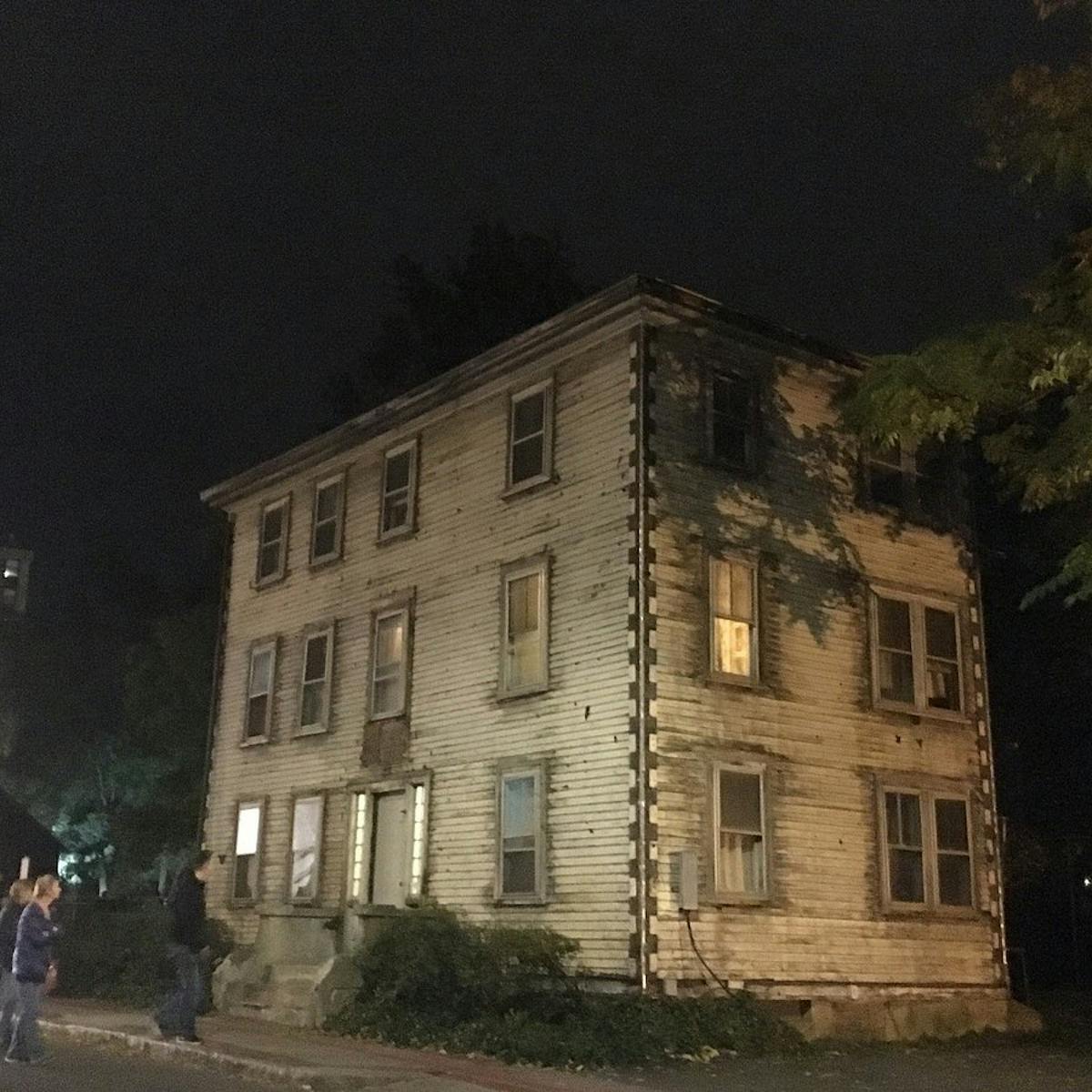
Protect Your Trip »
The 5 Best Salem Tours
From its infamous witch trials to its scenic harbor, this Massachusetts city is ripe for exploration.

Courtesy of Fame of Salem
See Salem from its waters during a tour with Fame of Salem.
Note: Some tour providers on this list may have ceased operations due to COVID-19. Check with your tour operator about availability before you book.
While best known for its notorious witch trials in the late 1600s, Salem, Massachusetts, has a lot more to offer. These Salem tours offer an in-depth look at everything related to the trials, but they also explore the area's landmarks and Revolutionary War history. U.S. News selected the following tours by consulting traveler sentiment and expert opinion. Whether you explore by day or by night, these excursions will introduce you to all sides of Salem.
Fame of Salem – Sail on the Fame
Set sale on a replica of an 1812 privateer schooner on this nearly two-hour cruise. Not only do tourgoers see Salem from the water, but they also learn about the original Fame ship and the War of 1812. Travelers will also have the opportunity to assist the crew with raising the sail and other tasks. Passengers say the sail was one of the highlights of their trip to Salem and praise the expert crew. Tickets cost approximately $40 for participants ages 14 and older and $30 for youths ages 13 and younger. Tours are available May through October several times daily a few days a week; availability depends on the season. Fame of Salem also offers a sunset cruise, as well as private charters.
[ View & Book Tickets .]
Bewitched After Dark Walking Tours
On this two-hour walking tour from Bewitched After Dark, travelers learn about colonial Salem, along with its ample witch-related history. Along the way, tourgoers will pass by more than a dozen historical locations within the downtown area. Reviewers praise the guides for their storytelling abilities and recommend the tour for history buffs. Many also add that this tour turned out to be the highlight of their visit to Salem. Tickets cost approximately $30 per person; children 7 and younger can participate for free. Tours operate nightly at 7 p.m.
Spellbound Tour
Led by paranormal investigators, this trip focuses on more than the city's fabled witches. During the 90-minute tour, guides will share stories about Salem's ghosts, New England vampirism and Voodoo while visiting haunted sites like the Salem Jail and the Joshua Ward House. Guides will also teach participants how to hunt for ghosts and take images of spirits with their cameras. Reviewers say this is an informative and historically accurate tour and that it's one of the best ghost tours they've attended. Tickets start at $21 for participants 11 and older. Tours are available at 8 p.m. nightly; there's also a 2 p.m. tour offered Friday through Sunday.
Salem Night Tour
Explore downtown Salem at night and learn about the city's history while listening to ghost stories on the Salem Night Tour, which lasts about 90 minutes and covers roughly 1 mile. As an added bonus, the company says the tour's content is appropriate for children. Travelers give high marks to guides, describing them as knowledgeable and engaging. Tickets start at $25 per person. Tours operate daily at 8 p.m. The company also offers a daytime tour at 2 p.m.
Witch City Walking Tours – History & Hauntings of Salem
Those with an interest in Salem ghost stories should sign up for this two-hour walking tour led by a local historian. If you'd like to boost the eerie factor, opt for a night tour when you'll be led around town by lantern. Stops on the tour include the Old Burying Point Cemetery, the seaport and the Old Town Hall. Tour-takers describe guides as passionate about Salem and say the tour is full of great stories. Tickets cost approximately $25 for adults with discounts for seniors, students and children. Tours run daily at multiple times. The company also offers a Mysteries and Murders of Salem tour.
You may also be interested in:
- The Best Boston Tours
The Best Whale Watching in Cape Cod
- The Best Weekend Getaways in New England
- The Best Things to Do in Boston
- The Best Hotels in Boston
Tags: Tours , Travel , Vacations , Massachusetts
World's Best Places To Visit
- # 1 South Island, New Zealand
- # 4 Bora Bora
If you make a purchase from our site, we may earn a commission. This does not affect the quality or independence of our editorial content.
You May Also Like
The 15 best chicago tours for 2024.
John Rodwan May 1, 2024

The 10 Best Harry Potter Tours in London
Marisa Méndez April 30, 2024

12 Cheap Fourth of July Getaways
April 29, 2024

The Best Tours of Buckingham Palace
Laura French April 29, 2024

Flight Canceled or Delayed? What to Do
Amanda Norcross April 26, 2024

The Best Beach Hats
Megan Johnson and Sharael Kolberg April 26, 2024

The Best Florence Tours
John Rodwan April 25, 2024

The 9 Best Louisiana Swamp Tours of 2024
John Rodwan April 24, 2024

How Much Does a Cruise Cost?
Gwen Pratesi April 24, 2024

Lyn Mettler April 24, 2024

iseesalem Podcast Walking Tours.
See Salem from a whole new perspective, Your Own!
Witch Trials Walking Tour
Tour the sites associated with the Salem Witch Hysteria. The location of the jail where the accused were held. Homes and burial sites of those involved with the trials and the memorial dedicated to the victims.
Revolutionary War Audio Tour
Learn about Salem’s role in the Revolutionary War. See the site of the first act of the war. Homes of prominent war officers. Learn how Salem’s privateering played a part.
Salem’s Cemeteries Audio Tour
Explore Salem’s cemeteries!
See Salem From a Whole New Perspective. Your Own!
Salem, Massachusetts. Mostly known for the witch trials of 1692, Salem, MA is a lovely coastal city with a rich history.
Download these walking tour podcasts and enjoy learning about Salem’s history at your pace. You will discover tales of Salem’s famous residents, long nautical history, haunted sites, witch history, and more!
Why iSeeSalem Walking Tours?
- Learn about Salem on your Schedule. No rushing to certain place, at a certain time.
- Beat the Crowds! No crowds, No noise, and you can rewind and play again if you miss something.
- Learn about Salem’s history ANYWHERE. Even from your own home.
- Stop and Start when you wish. Feeling Peckish? Stop for lunch. Tour will begin again when you want.
About iSeeSalem.com Podcast Walking Tours?
iSeeSalem.com walking tours was founded 2008 with the intent of offering Salem’s tourists a new way to learn about the city and its history.
iSeeSalem.com offers downloadable podcast walking tours of some of Salem’s most popular sites.
The podcast walking tour format allows tour takers to participate at their own pace and on their own time.
Salem Walking Tours
Salem cemeteries walking tour, nathanial hawthorne walking tour, revolutionary war walking tour, salem witch trials walking tour.
Copyright 2016 iSeeSalem Inc. All audio and tour info is property of iSeeSalem Inc. Protected by U.S. and international copyright laws.

Orientation
Salem is a popular tourist destination, so check out these websites for tours, attractions, restaurants, hotels, and shopping suggestions as well as event listings. Some of Salem’s historic sites and attractions are seasonal, so contact them beforehand. Spring and summer are great times to visit.

Destination Salem , 245 Derby Street. The office of tourism & cultural affairs.
Haunted Happenings , the official website for Halloween in Salem. This month-long celebration includes lots of events and people. Warning: If you don’t like waiting in lines with people in costumes, October may not be the best time for you to visit.
Start your adventure near the Essex Street pedestrian walkway by the parking garage:
National Park Service Visitor Center , 2 New Liberty Street. Salem Maritime park has downloadable self-guided walking tours and an “Architecture in Salem” guide so you can view some of the 17 th century buildings still standing. Pick up a map and watch the movie Salem Witch Hunt: Examine the Evidence (38 minutes).
Salem Heritage Trail . The red (or yellow) line painted on the sidewalks connects some of Salem’s historically significant sites and neighborhoods, though swerves to include some tourists traps too.

Salem’s architectural beauty and maritime endeavors are on full display, alongside modern-day witch shops and tourist attractions, but much tangible evidence of the witch trials has disappeared.
Beadle Tavern site , 65 Essex Street. Location of some witch examinations.
Bridget Bishop House and Orchard site , 43 Church Street. Bridget Bishop was the first person hanged for witchcraft in 1692. Lyceum Hall, the brick building now standing at Bridget’s former homesite, was built in 1831 to host educational lectures and entertainment. The Hall is most famous for Alexander Graham Bell’s 1877 demonstration of his telephone, though it’s also where Charles W. Upham (1802-1875) lived when he became intrigued by Salem’s witch-hunt past and started writing about it. The building is now Turner’s Seafood restaurant .

Gov. Simon Bradstreet house site , 134 Essex Street. After his first wife—the poet Anne (Dudley) Bradstreet (c.1610-1672)—died, Gov. Bradstreet (1604-1697) married Anne (Downing) Gardner (1633-1713) and moved to her house on Essex Street. He served again as (acting) governor from 1689 to May 1692, before Sir William Phips arrived with the Royal Charter.
Broad Street Cemetery , 5 Broad Street. Established 1655. Burial place of witch trials Judge Jonathan Corwin (1640-1718) and his nephew, sheriff George Corwin (1666-1696).
Burying Point , 51 Charter Street. Established 1637, earliest extant gravestone 1673. Also known as Charter Street Cemetery. Burial place of 1692 Judge John Hathorne (1641-1717); Rev. John Higginson Jr. (d. 1718); Judge Bartholomew Gedney (1640-1697); Elinor Hollingsworth (d. 1689), mother of accused Mary English; Samuel Shattuck (d. 1695), a child supposedly bewitched by Bridget Bishop; Giles Corey’s second wife Mary (1621-1684); Gov. Simon Bradstreet (1603-1697); and Nathaniel Mather (1669-1688), younger brother of Rev. Cotton Mather. The Witch Trials Memorial is adjacent to the cemetery.
George Corwin house site , 148 Washington Street. The notorious sheriff’s house was replaced in 1784 by Joshua Ward’s home. In 2015, Lark Hotels turned the Ward home into a boutique hotel called The Merchant .
Court House site , Washington Street by Lynde Street. 1677-1718. See bronze tablet at Masonic Temple, 70 Washington Street. The original courthouse, located in the middle of today’s Washington Street, held the Court of Oyer and Terminer where accused witches were brought to trial in 1692. The building was torn down in 1760.

Philip English house site , 11 Essex Street. Built around 1685, this was the home of accused witches Philip English (1651-1736) and his wife Mary (Hollingsworth) English (c. 1652-c. 1696) who escaped from the Boston jail. The mansion was torn down in 1833.
Essex County Law Library , Essex County Superior Court, 56 Federal Street. Look for glass-topped pedestal display case , with copies of two witch trials documents, witch pins, and county seal.
First Church of Salem original meetinghouse site, 231 Essex Street. Rebecca Nurse (1621-1692) was a member of the Salem Town church, though she often attended the Salem Village church closer to her home. After being sentenced for witchcraft, she was excommunicated from this church in 1692. The current brick building was built in 1826 by members of Salem’s First Church, with the second floor used for church services while the first floor offered retail space, including Daniel Low’s jewelry store. In 1892, Daniel Low & Co. started the first mail order catalog and sold silver Salem Witch souvenir spoons. The company took over the building when the congregation moved to 316 Essex Street. It’s now Rockafellas restaurant.
Friends Cemetery (a.k.a. Quaker Cemetery), 396 1/2 Essex Street. First burials circa 1680. Many of the graves are unmarked.
Gedney house , 21 High Street. Built in 1665 for shipwright Eleazer Gedney (1642-1683), the earliest section of this house shows the typical 17th century floor plan with two main rooms on each side of the central chimney. Although Eleazer died before the Salem witch trials, his brother Bartholomew (1640-1698) was a magistrate for the Court of Oyer & Terminer and no doubt frequented the house. Eleazer’s first wife Elizabeth was sister to John Turner who built the House of the Seven Gables. His second wife Mary (d. 1716) lived here in 1692.
John Hathorne house site , Lapin Park ( Bewitched statue’s location), 114 Washington Street on corner with Essex Street. Judge John Hathorne (1641-1717) lived here during the witch trials. His mansion burned down in 1774.

House of the Seven Gables , 115 Derby Street. Built in 1668 by merchant John Turner (d. 1680) and made famous by Nathaniel Hawthorne’s novel of the same name (1851), the Turner-Ingersoll mansion was restored in 1912 to show off its First Period architecture. Tourists come to see the historic house that captured Hawthorne’s literary imagination. Set in the mid-19th century, the novel dwells on ancestral guilt related to the witchcraft trials. Designated a National Historic Landmark District, the Gables property includes the Retire-Beckett House (c. 1655), the Hooper-Hathaway House (c. 1682), and the birthplace of Nathaniel Hawthorne (c. 1750). In 2018, the House of the Seven Gables celebrates its 350th anniversary.
Howard Street Cemetery , 29 Howard Street. First burial 1801. Located next to the 1813 jail. If your tour guide talks about the ghost of Giles Corey, you’re on the wrong tour. This was private property in 1692.
Rev. John Higginson house site , near 19-1/2 Washington Square North. Higginson was the senior minister of Salem Town in 1692. His daughter Ann (Higginson) Dolliver (c. 1650-1739) was accused as a witch and confessed.
Thomas Maule house site , 331 Essex Street. An outspoken Quaker who had a few run-ins with the law, Thomas Maule (1645-1724) was imprisoned for almost a year in 1695/6 for his “slanderous” book, Truth Held Forth , his autobiography and witch-hunt diatribe. The jury found him not guilty. His wife Naomi testified against Bridget Bishop in 1692.
William Murray house , 39 Essex Street. Originally built 1688. William Murray served as a court clerk at some of the Salem witch trials. He also accused his neighbor Alice Parker.

Alice (–) Parker house site , between 54 and 58 Derby Street. Executed witch Alice Parker (d. 1692) rented small house from Philip English.
Peabody Essex Museum , 161 Essex Street. An international art, architectural, and cultural museum, the Peabody Essex started as the East India Marine Society in 1799. Through mergers of several societies, the museum grew from seafaring treasures to include local history, nature, and science collections. On display is the 1679 valuables chest made to commemorate the marriage of Joseph and Bathshua (Folger) Pope. During the trials, Bathshua was an afflicted accuser naming Rebecca Nurse and Martha Corey while her husband Joseph also spoke out against John Proctor. All three victims were hanged. The 1680 cupboard was made for Benjamin Putnam (1664-1715), who signed the petition in support of Rebecca Nurse. Samuel Sewall (1652-1730), the only judge who publicly apologized for his part in the witch trials, is shown in a portrait by painter John Smibert. PEM somestimes has special exhibits that feature its witch trial-related artifacts. The Phillips Library Reading Room is now part of the new Collection Center in Rowley .

Pioneer Village , Forest River Park, West Avenue extension. Owned by the city of Salem. To commemorate the 300-year anniversary of the Massachusetts Bay Colony, in 1930 Salem recreated a 17 th century village depicting dugouts, wigwams, thatched-roof cottages, and the Governor’s Faire House. As America’s first living history museum, Pioneer Village features costume guided tours and special events, such as craft or pioneer life demonstrations and storytelling. It’s especially spooky at night, when you may think the devil is at the door. Check for special events.
Proctor’s Ledge Memorial , 7 Pope Street. In early 2016, the Gallows Hill Project team confirmed Proctor’s Ledge was the execution site of the witch trial victims (and not the pinnacle at Gallows Hill). In 2017, a memorial for the 18 hanging victims was dedicated.
Ann Pudeator house site , 35 Washington Square North. Second wife and widow of Jacob Pudeator (c. 1645-1682), executed witch Ann (–) (Greenslit) Pudeator (c. 1625-1692) was a midwife and nurse.
Quaker Meeting House , Federal Garden area, Essex Block. The first Friends’ meeting house was built in 1688. In 1865, the Essex Institute recreated the meeting house in the First Period style using beams thought to be original to the first Quaker church. Connection to Thomas Maule and accuser Bathshua Pope. Located at the Peabody Essex Museum gardens; not open to the public.
Salem Gaol site , 2-4 Federal Street. Some of the witch-hunt victims were incarcerated in the wooden Salem jail built in 1684. Most likely, Giles Corey (c. 1617-1692) was pressed to death on the grounds of the jail. In 1763, the jail was replaced by a larger one at the same property. (In 1813, the prisoners were moved into the new stone prison around the corner, on what is now 50 St. Peter Street.) In the 19th century, the 1763 jail was renovated into a family home, and in 1935, opened as the second witch city attraction, the Old Witch Jail and Dungeon. The building was torn down in 1956. There’s a plaque on the current brick building.

Salem Witch Trials Memorial , 51 Charter Street. After the witch trial hangings, family and friends secretly buried the bodies, leaving no signs to mark their final resting places. For the 300th anniversary of the Salem witch trials in 1992, a special memorial was dedicated next to Old Burying Point so we can honor and remember these 20 victims.
John Ward house (1684), Federal Garden area, Essex Block. This First Period home sat across from the old witch gaol until it was moved in 1910. (Its prior location and age put it on this list; no known witch hunt connections.) Tours available with Peabody Essex Museum ticket.
Witch House , 310 ½ Essex Street, Salem. Owned by the city of Salem. Billed as the only building in Salem with direct ties to the witch trials, this was Judge Jonathan Corwin’s house in 1692. Although tradition says some of the preliminary examinations were held here, it’s unlikely it was used for anything more than private meetings. The house is decorated for a well-to-do 17th century family, though no items are related to the Corwins. However, a shadowbox hanging on the parlor wall contains John Proctor’s two-tined fork with bone handle. You’ll also find a witch bottle used to ward off evil spirits (and usually filled with urine, fingernails, hair, pins, and nails) and a poppet. The Corwin house is open for tours and holds special events.
Peabody Essex Museum , 161 Essex Street. PEM owns the largest collection of items connected to participants of the Salem witch trials. 1692: The Salem Witch Trials exhibit on view July 6, 2024 to June 1, 2026.
Attractions
Be aware that some attractions need serious refurbishing and their narratives need updating to include new research and to remove historical inaccuracies.
Cry Innocent: The People Versus Bridget Bishop by History Alive Inc., Old Town Hall, 32 Derby Street. Think you can’t get caught up in the drama of 1692? This interactive play based on Bridget Bishop’s testimony invites you to ask questions and decide whether her case should be brought to trial based on the evidence you’ve heard.
Salem Tour Association , a collective of tour companies based in and operated out of Salem, Massachusetts, who have agreed to a code of conduct and higher than average standards.
Book with local tour guides, not national or regional ones. Be aware that some tour guides are actors who follow a script and don’t know Salem’s history otherwise.
Salem Trolley : Get to know the city, its history and landmarks with a one-hour narrated ride.
Annual Salem Calendar
January : Salem Comedy & Spirits Festival February : Salem’s So Sweet chocolate & ice sculptures festival March : Salem Restaurant Week ; Salem Film Fest ; Salem’s Women’s History Day April/May : Salem Ancestry Days May : Mass Poetry Festival June : Salem Arts Festival ; North Shore Pride Weekend July : Salem Celebrates the Fourth August : Salem Heritage Days ; Salem Maritime Festival ; Antique & Classic Boat Festival September : Salem Spice Festival; Salem Food Truck & Craft Beer Festival ; Salem Lit Fest ; Trails & Sails October : Salem Haunted Happenings (Oct. 1-31) November/December : Salem holiday events December : Christmas in Salem homes tour
Historic Salem Inc .’s website features a database of 500+ house histories as part of historic plaque project.
Preserving Salem for information on Salem’s local historic districts, highlights Salem’s historic assets, and features examples of outstanding public and private initiatives to protect, preserve and promote the city’s irreplaceable historic resources
Salem Public Library , 370 Essex Street. Check out the Salem History room on the third floor for books, vertical files, directories, and newspapers. Also the SalemWiki: Salem Links & Lore and Digital Heritage collection.
Online Books & Records
Annals of Salem by Joseph B. Felt Vol. 1 (1845) and Vol. 2 (1849)
CemeteryFind: Greenlawn Cemetery
Historical sketch of Salem, 1626-1879 by Charles S. Osgood (1879)
History of Salem by Sidney Perley (1924-28) Vol. 1: 1626-1637 , Vol. 2: 1638-1670 , Vol. 3: 1671-1716 ; also look for his “Salem in 1700” articles in the Essex Antiquarian
Old Naumkeag: an historical sketch of the city of Salem, and the towns of Marblehead, Peabody, Beverly, Danvers, Wenham, Manchester, Topsfield, and Middleton by Charles Henry Webber and Winfield S. Nevins (1877)
Records of the Salem Commoners 1713-1739 by George Francis Dow (1903)
Salem Town Records
Town Records of Salem, Massachusetts published by the Essex Institute Vol. 1: 1634-1659 , Vol. 2: 1659-1680 , Vol. 3: 1680-1691
Wicked Salem: Exploring Lingering Lore and Legends
Tituba, Indian Servant of Mr. Samuel Parris
Capitalizing on seasonal interest in the Salem witch trials
Misconceptions about the 1692 Salem witch hunt
Where did accused witch Bridget Bishop live?
Why go to Rowley? Salem’s PEM research library of course
A tribute to the Essex Institute—and Mary English’s chair
Looking at Salem from the outside in with J.W. Ocker
Why not ergot and the Salem witch trials?
Switching sides: Tony Fels takes on the classic Salem witch hunt books
Teaching the everyday & the extraordinary: Salem in 1692
Bernard Rosenthal: Lessons to learn from the Salem witch hunt
Which Bishop? The one that got away
Witches and witchcraft with Tom the tour guide
Emerson W. Baker on Twitter @EmersonWBaker : history professor at Salem State University, author of A Storm of Witchcraft and The Devil of Great Island .
Donna Seger on Streets of Salem blog: history professor at Salem State University. Writes about “culture, history, and the material environment, from the perspectives of academia, Salem and beyond.”
Ty Hapworth as hellosalem on Instagram. Great photos of Salem people, places, events.
Share this:
- Students & Group Tours
- Haunted Happenings
- Visitor Centers

- Notable Locals
- 10 Free Things to Do in Salem, MA
- The Destination Salem Radio Show
- Education & Community
- Native History & Indigenous Acknowledgement
- Weekend at a Glance
- All Listings
- Museums & Attractions
- Psychics & Spiritual Growth
- Salem Heritage Trail
- Sweets & Treats
- Restaurants
- Witch Shops & Occult
- Chocolate & Candy
- Inns and B&Bs
- Regional Accommodations
- Transportation
- Map of Salem
- Information Centers
- Salem Witch Trials of 1692
- Modern Witch & Occult
- Hocus Pocus
- The Journey from 1692 to Salem’s Modern Witch Community
Home » Blog » Do » See the Sights from Salem’s Heritage Trail

See the Sights from Salem’s Heritage Trail
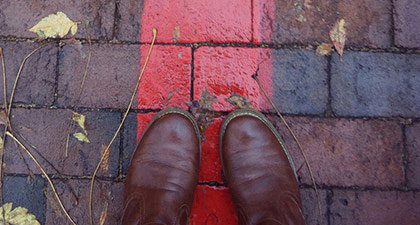
The Salem Heritage Trail exists to guide visitors between historic sites and destinations. Intended to inspire self-guided exploration, there are a few stops along the way that you might not want to miss.
The National Park Service Salem Regional Visitor Center , 2 New Liberty Street, is a perfect place to start. Watch the free 27-minute film, Where Past is Present , which appeals to all ages and provides an overview of Salem’s and Essex County’s history.
Please note: While the Visitor Center is currently closed for the season, this is still a central location to start your walk along the trail. Parking is available right across the street from the visitor center at the Witch City Mall Garage and around the corner in the Church Street Lot. (During this time, visitor information is available at Waite and Peirce on Derby Street). From the Visitor Center, cross the street…

The Peabody Essex Museum , 161 Essex Street, is the oldest continually operated museum in the country. The museum features exceptional collections of art and culture as from around the world including Asian art, Asian export art, Maritime art, Native American art, as well as changing exhibits and programming.
If time allows, we always recommend a visit to the museum. 2021 exhibitions include The Salem Witch Trials 1692 , Salem Stories , and Made It: The Women Who Revolutionized Fashion . To plan your visit this year , and to find admission information and exhibit schedules, visit pem.org . Continue west on Essex Street…
East India Marine Hall faces the fountain at East India Square and contains the original display cases and some of the very first objects collected by the Salem captains who established the Peabody Essex Museum in 1799. Continue along Essex Street…

You will pass boutiques, shops, cafes, and the Witch History Museum . At the corner of Essex and Washington Streets, pause at the former Daniel Low Building to read the plaque that notes the building as the site of Salem’s first Town Hall, and the location where delegates for the first Continental Congress were chosen in 1774. Turn around and you will see…
The fountain in Town House Square marks the supposed location of Salem’s first fresh water source, which was immortalized by Nathaniel Hawthorne in his short story, A Rill from the Town Pump . The 1970s era fountain was restored in 2014, when a marble base with Hawthorne’s words was installed. Cross Washington Street to…
The statue of Samantha Stevens from Bewitched . The television series filmed several episodes in Salem in the early 1970s after fire damaged the studios in California. The statue was erected by TV Land in 2005, and today she is one of the most photographed landmarks. Continue along Essex Street, cross Summer Street and…

You will see the 17th-century Witch House . The only building still standing in Salem with direct ties to the Salem Witch Trials of 1692 , this was the family home of Judge Jonathan Corwin. Across the street you will see…
A monument remembering Salem Captain William Driver , who named the American flag “Old Glory.” Today, that flag, which was given to Driver by his mother as he departed on a trip, is part of the Smithsonian collection.
Adjacent to the Driver plaque is the entrance to the Samuel McIntire Architectural District , which includes a walk down Chestnut Street passing the Phillips House Museum .
Adjacent to the Witch House is the First Church in Salem, which was the parish of many of the accused during the Salem Witch Trials . This church features stunning Gothic architecture and Tiffany windows.

The Heritage Trail finds its end on Essex Street at the Ropes Mansion , which is part of the Peabody Essex Museum collection. The Ropes Gardens are open and free to the public.
Reversing direction, turn left on North Street and continue to Lynde Street. Turn right on Lynde and walk to the Witch Dungeon Museum , which features a plaque that remembers “The With Gaol.” The original “gaol” (jail) was located on Federal Street, two blocks from the Witch Dungeon Museum (not on the Red Line). Continue along Lynde Street and turn right onto Washington Street…
Salem City Hall at 93 Washington Street was built in 1837-38 from funds dispersed to Salem from a US Treasury Surplus. The Mayor’s office and City Council chambers have remained unchanged since 1838. Continue to Front Street, so named because this was the original Salem Waterfront. Turn left, walking past…
Old Town Hall in Derby Square. The oldest surviving municipal structure in Salem, Old Town Hall dates back to 1816-17. The second floor of the building, Great Hall, has always been used as a public hall, and contained Town offices until 1837. The first floor functioned as a public market and today is home to the Salem Museum. Follow Front Street, which will turn into Charter Street…

The Old Burying Point Cemetery is the second oldest English cemetery in Massachusetts. This Cemetery has a few remarkable residents including one Mayflower passenger, architect Samuel McIntire, and Witch Trials Judge John Hathorne (great grandfather to Nathaniel Hawthorne).
Behind the cemetery on Liberty Street is the Salem Witch Trials Memorial . Dedicated in 1992 by Nobel laureate Eli Wiesel, pause to pay respects to the 20 innocent people executed during the Witch Trials of 1692.
From the Memorial, follow the Heritage Trail down Liberty Street past the Salem Wax Museum and Witch Village , turning left onto Derby Street. You will pass shops, restaurants, and the New England Pirate Museum on your way to the waterfront, where the Red Line turns right and loops through the shops and restaurants of Pickering Wharf.

On the eastern side Pickering Wharf, there is a plaque remembering the Frigate ESSEX, which was constructed on Winter Island. She sailed from Salem in 1799 to serve in the Barbary Wars and the War of 1812. Her story was “epic in Naval history.”
Back on Derby Street, turn right toward the Salem Maritime National Historical Site , where historic buildings, wharves, and the reconstructed tall ship FRIENDSHIP tell the stories of the sailors, Revolutionary War privateers, and merchants who brought the riches of the world to America.
Continue down Derby Street to Ye Olde Pepper Companie , a candy store noted for its Gibralters and Blackjacks, two of the first commercially produced candies in America. Across Derby Street you will find…
New England’s oldest wooden mansion, The House of the Seven Gables , which was made famous by the novel by Nathaniel Hawthorne it inspired. Today it is part of its own National Historic District, comprised of the Turner-Ingersoll Mansion, Hooper-Hathaway House, Hawthorne’s birthplace, and the seaside gardens.

From here the Heritage Trail continues two blocks to Blaney Street and Salem Wharf, where the Salem Ferry to Boston docks. Reverse direction, and return from the waterfront via the path that cuts through the National Park between the brick Derby House and the yellow Hawkes House, passing the 17th-century Narbonne House onto Essex Street.
Turn left on Essex Street and walk to Hawthorne Boulevard, turning right at the corner by the Hawthorne Hotel . Recognized as a Historic Hotel of America, the Hawthorne was built by public subscription in 1925.
Adjacent to the Hawthorne Hotel is Salem Common , which was established as a public grazing land in the 17th-century. In the 18th-century it was used as a training ground for the militia, and was the location of the first muster of the American National Guard.

Across from the northwest corner of Salem Common is the statue of Roger Conant . Conant founded Salem in 1626 for the Dorchester Company from England. Behind the Conant statue in an 1845 stone building that was once the Second Church Unitarian, is the Salem Witch Museum.
Turning back toward Essex Street, the Red Line turns right and returns to the tour’s beginning at the Salem Regional Visitor Center. This last block is significant however, as it includes Crow Haven Corner , which is thought to be the first witch shop in America, on the left, and several significant buildings on the Peabody Essex Museum campus on the right.
However you choose to follow Salem’s Heritage Trail, the three loops of Red Line have four centuries of stories to tell and dozens of sites to visit along the way.
Categorised in: Do
Tags: Family , Free , History , Outdoor , Seventeenth Century , Things To Do , Walking
Recent Blogs
MUM’S THE WORD ON THIS SALEM SECRET
Salem’s Soundtrack: THE RECORD EXCHANGE AT 50
April Vacation is No Joke in Salem, MA
SPIRITS ARE HIGH IN SALEM, MA
Get Your Free Guide To Salem

Privacy Overview
- Pre-Colonial Mass
- 17th Century Mass
- 18th Century Mass
- 19th Century Mass

Salem Witch Trials: Historical Sites & Locations
Many of the historical sites and locations related to the Salem Witch Trials still exist in and around Salem as well as other areas.
Visiting these sites is a great way to experience the history of the trials firsthand.
The Salem Witch Trials took place in a settlement within the Massachusetts Bay Colony named Salem which, at the time of the trials in 1692, consisted of two sections: Salem town, which is now modern-day Salem, and Salem Village , which is now modern-day Danvers .
Many people like to argue that the witch trials didn’t really happen in Salem and instead took place in Danvers. This is not entirely true. The Salem Witch Trials did begin in Danvers, but the events of the trials actually took place in both Salem and Danvers.
The early events of the witch trials, particularly the first handful of accusations and pretrial examinations, occurred in Salem Village in March of 1692. The accusations and examinations then quickly spread to Salem town.
The majority of the accused witches were held in the jail in Salem town (as well as jails in Ipswich and Boston). The actual witch trial cases themselves were heard in the courthouse in Salem town and the convicted witches were executed and buried in Salem town (although a few of the bodies, such as Rebecca Nurse, John Proctor and George Jacobs Sr , were reportedly retrieved by their family members and reburied on their family properties in Salem Village.)
Although some of the events did happen in Danvers, one reason the town doesn’t get the massive influx of tourists like Salem does is because it doesn’t have the same name as the trials anymore (the town’s name was changed from Salem Village to Danvers in 1752.)

Another reason is because Danvers is a small suburban town and the locations of the Salem Witch Trials sites in Danvers are spread out over miles. They’re not conveniently clustered in the downtown area of a small city like they are in Salem.
Despite their numerous locations, the witch trials historic sites in Salem and outside of it are still easy to find and are well worth traveling to.
If you’re visiting Salem, you can see the sites there by simply following the heritage trail around the downtown area or by taking a Salem history tour .
There are also many other witch trials historic sites across the north shore of Massachusetts, which most can be reached by car or bus.
Some of these historical sites are well preserved and are frequently visited by tourists, but many of them are long forgotten. Only a few of these sites still have the original buildings from that time period. The other buildings have either fallen into ruins, burned down or were torn down to make way for more modern buildings.
The following is a list of historical sites related to the Salem Witch Trials, divided by town:
WENHAM, MASS:
♦ Claflin-Gerrish-Richards House: Website: wenhammuseum.org Address: 132 Main Street, Wenham, Mass
This was the home of Reverend Joseph Gerrish in 1692. It was here that Gerrish and Reverend John Hale met with one of Gerrish’s parishioners, Mary Herrick, who then accused Hale’s wife of witchcraft and said the ghost of Mary Easty visited her and told her she was executed unjustly.
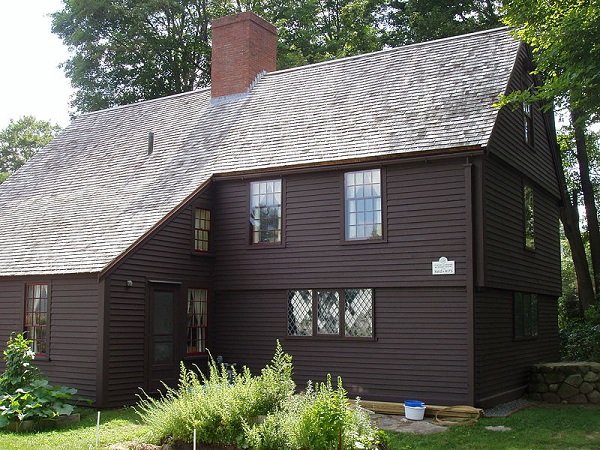
The house, which was built sometime between 1662-1673, still stands today and serves as the office of the Wenham Historical Association. It is open to the public.
Reverend Joseph Gerrish, Thomas Fisk & William Fisk’s Graves: Address: Old Wenham Burying Ground, Wenham, Mass
Reverend Joseph Gerrish was buried here after he died in 1720 at the age of 70. Also buried here are Thomas Fisk, who died in 1723 at the age of 70, and William Fisk, who died in 1727 at the age of 85.
Both men were jurors in the Salem Witch Trials and both men reportedly signed a confession of error in 1697 stating that they were “sadly deluded and mistaken” during the trials.
Topsfield, Mass:
♦ Site of Sarah Wildes Home Address: Triangular area between Perkins Row and Meetinghouse Lane, Topsfield, Mass
♦ Pierce Farm Address: 116 Boston Street, Topsfield, Mass.
The foundation of Pierce Farm includes a section of of the 1690s farmhouse owned by Isaac Easty, son of Mary Easty. Mary Easty was arrested at this farmhouse in 1692.
SALEM, MASS:
♦ The Witch House: Website: witchhouse.info Address: 310 Essex St, Salem, Mass
The Witch House was the home of Jonathan Corwin who was a judge in the Salem Witch Trials. Corwin purchased the house in 1675 and lived there for 40 years until his death in 1718.

The house remained in the family until the 1850s when it was sold to a pharmacist named George Farrington who added a pharmacy to the side of the building.
In 1944, the building was moved back from the street about 35 feet to allow North street to be widened. The house was restored at the time to look as it would have in the 17th century. The house officially opened as a museum in 1946.
♦ Site of the Old Salem Jail: Address: corner of St. Peter and Federal Street, Salem, Mass
The jail that the accused witches were kept in was a small wooden structure with a dungeon underneath.

The accused witches were considered very dangerous prisoners and were kept in the dungeon and chained to the walls to prevent their spirits from escaping and tormenting their victims.
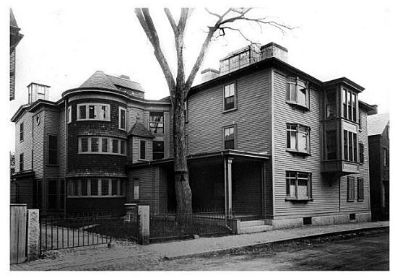
In 1813, the old witch jail was abandoned when a new jail was built down the street.
In 1863, Abner Cheney Goodell purchased the structure of the old jail and remodeled it into a home. In 1935, Goodall’s son Alfred and his wife began offering tours of the home and the old dungeon underneath.
In 1956, the New England Telephone Company razed the house and constructed their new headquarters, a large brick building, in its place.
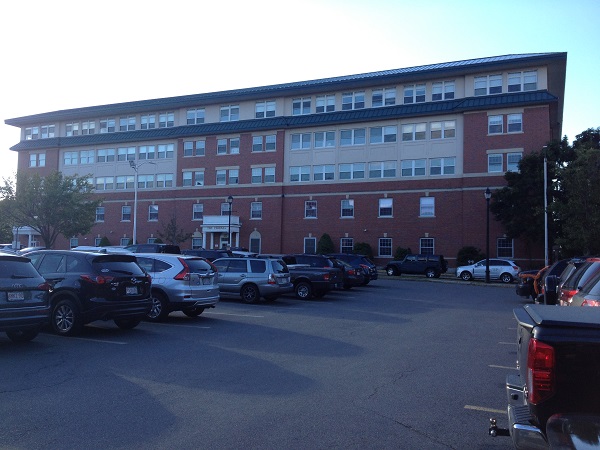
A plaque dedicated to the old jail can be found on the front of the brick building at 10 Federal Street.
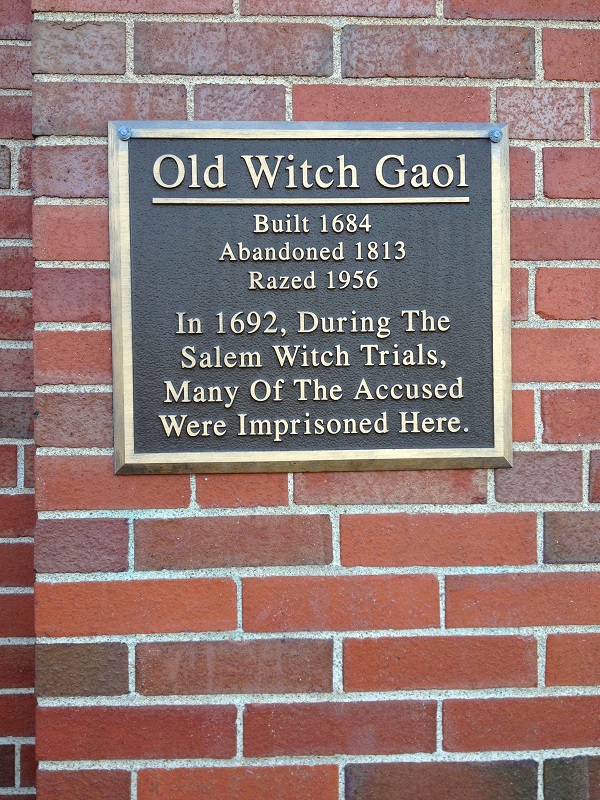
When construction workers were digging the new foundation for the brick building, they unearthed the old dungeon where the accused witches were kept.
Several wooden beams from the dungeon were recovered and donated to the Peabody Essex Museum. Two of these beams are now on display, one at the Salem Witch Museum and one at the Witch Dungeon Museum.
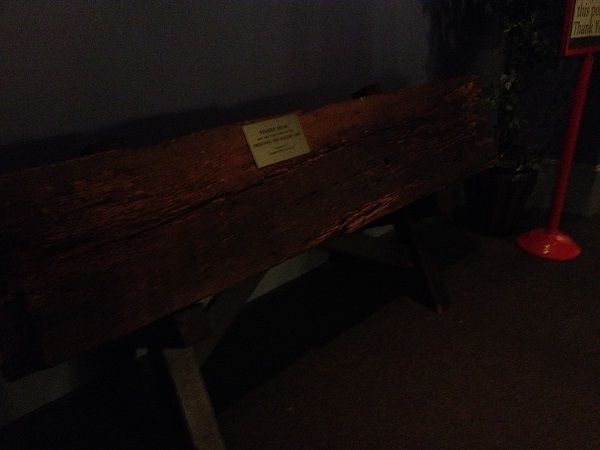
♦ Site of the Salem Courthouse: Address: Washington Street (about 100 feet south of Lynde Street), opposite the Masonic Temple, Salem, Mass
The Salem Witch Trials cases were heard in the courthouse in Salem town located in the center of Washington Street about 100 feet south of Lynde Street, opposite of where the Masonic Temple now stands.
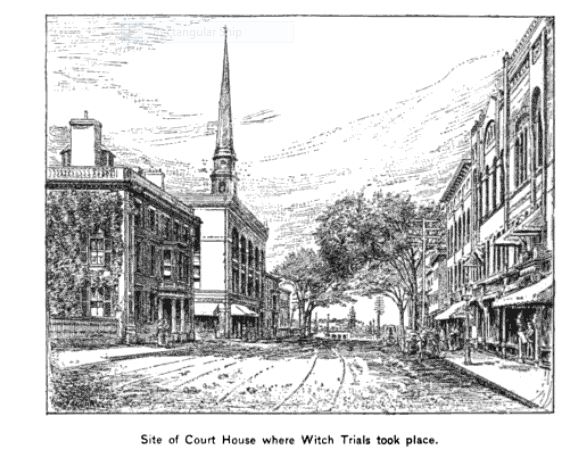
In 1760, this courthouse was torn down but a plaque dedicated to the courthouse can be found on the wall of the Masonic Temple on Washington Street.
♦ Site of Bridget Bishop’s Orchard & House: Address: 43 Church Street, Salem, Mass. Currently occupied by Turner’s Seafood restaurant.
Bridget Bishop was the first person tried for witchcraft during the Salem Witch Trials. At or around the time of the witch trials, she lived in a house at 43 Church street where she also had an apple orchard. Some of her accusers reported seeing her spirit flying through the apple orchard at night, knocking apples off the trees as she flew.
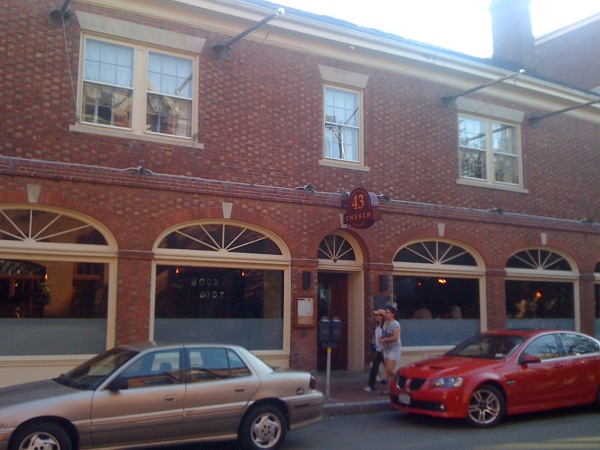
It is not known what happened to the house, but in 1831, the land was purchased by the Salem Lyceum Society who built the large brick building that still stands on this spot today.
The Lyceum building was used as a lecture hall and hosted such famous speakers as Henry David Thoreau, Frederick Douglass and Ralph Waldo Emerson. In 1877, the building hosted Alexander Graham Bell’s first public demonstration of the telephone. The building was later remodeled into a series of bars and restaurants.
♦ Site of Beadle’s Tavern: Address: south side of Essex Street, opposite of Washington Square E, Salem, Mass
Beadle’s Tavern was owned by Salem resident Thomas Beadle. A few of the accused witches’ pretrial examinations were held in the tavern.
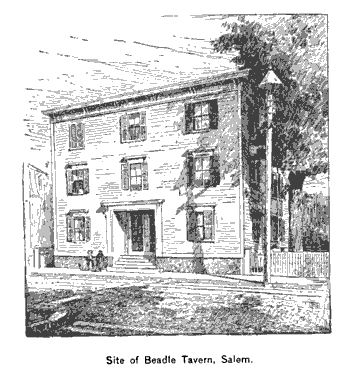
It is not known what happened to the tavern after the Salem Witch Trials but the building no longer exists.
♦ Site of Sheriff George Corwin’s House: Address: 148 Washington Street, Salem, Mass
Sheriff George Corwin was the High Sheriff of Essex County at the time of the Salem Witch Trials. He lived in a house on a plot of land at what is now 148 Washington Street.
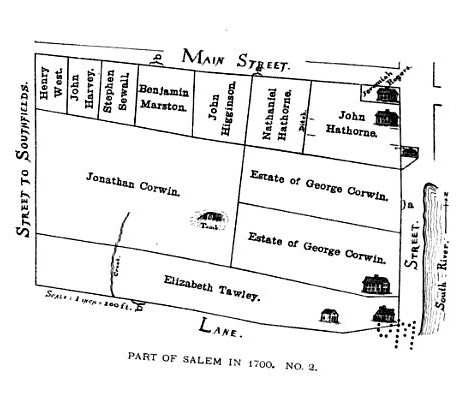
According to Upham in his book Salem Witchcraft, Corwin’s grandfather, also named George, previously lived in the house before moving into his newly built mansion on Essex Street in 1660. When Corwin died in 1685, he left the estate to Sheriff Corwin’s mother, Margaret. After she died sometime around 1691-92, Sheriff Corwin inherited it.
Sheriff Corwin died suddenly of a heart attack in 1696, at the age of 30, which is said to be the result of the Curse of Giles Corey , and left the estate to his wife. At the time Corwin died, surviving victims of the Salem Witch Trials, particularly Phillip English, were suing Corwin for damages after he confiscated goods and valuables of the accused during the witch trials.
Local legend says that English threatened to steal Corwin’s body and hold it for ransom. To prevent this from happening, Corwin’s family reportedly buried Corwin in the basement of his house. Corwin’s body was later reburied in the Corwin family tomb. When Corwin’s widow died in 1700, she left the estate to her son, Bartholomew Corwin.
Bartholomew sold the estate in 1714 and it changed hands a number of times over the next couple of decades until it was sold to local merchant Joshua Ward on August 11, 1781.
In 1784, Joshua Ward demolished Sheriff George Corwin’s house on the property and built a large brick mansion on the spot. This mansion still stands today and is currently a hotel known as The Merchant, named in honor of Joshua Ward.
♦ Judge Jonathan Corwin & Sheriff George Corwin’s Graves: Address: Broad Street Cemetery , Broad Street, Salem, Mass
The Corwin family tomb is marked by a short obelisk dedicated to the Corwin family. Jonathan Corwin was buried here in the family tomb when he died in 1718 at the age of 76. George Corwin died in 1696 at the age of 30 but wasn’t buried here until a later date.
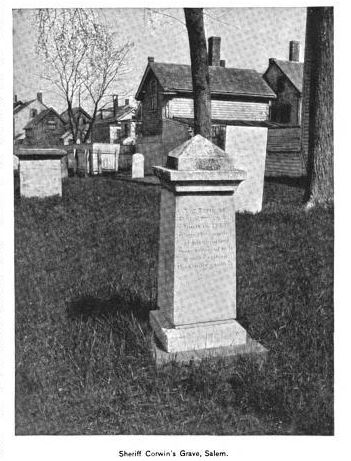
♦ Site of Judge John Hathorne’s Mansion: Address: 114 Washington Street, Salem, Mass
John Hathorne was a notorious judge in the Salem Witch Trials. Hathorne purchased this land, on the corner of what is now Essex and Washington streets (where the Bewitched statue now stands), from Deacon John Marston, Sr, on August 25, 1685.

Hathorne also owned the land west of it, which he purchased from John Fogg in 1675. Hathorne divided the tract of land west of his lot into house lots and sold the lots individually to his son Nathaniel Hathorne, John Higgins, Benjamin Marston, Stephen Sewall, John Harvey and Henry West in May of 1699.
After John Hathorne died in 1717, his mansion and land remained in the Hathorne family for several generations until it was sold to a woman named Mrs. Ropes in 1764. John Hathorne’s mansion burned down in the great fire of October 6, 1774 which also destroyed a nearby meetinghouse, seven other homes and 14 stores.
♦ Judge John Hathorne’s Grave: Address: Old Burying Point Cemetery, Charter Street, Salem, Mass
Judge John Hathorne was buried here after he died on May 10, 1717 at the age of 76.
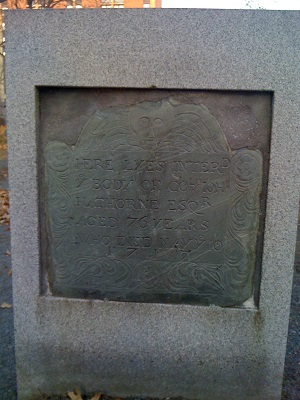
♦ Judge Bartholomew Gedney’s Grave: Address: Old Burying Point Cemetery, Charter Street, Salem, Mass
Bartholomew Gedney was a local physician and a judge in the Salem Witch Trials. Gedney was buried here after he died in 1697 at the age of 57.
♦ Site of Giles Corey’s Death: Address: Howard Street Cemetery, Howard Street, Salem, Mass
Giles Corey was a farmer from Salem Village who was accused of witchcraft in April of 1692. Corey was tortured here, which was then just a field next to the old Salem jail, in September of 1692 when he refused to enter a plea in his witchcraft trial.

Corey was forced to lie on the ground while a board was placed on top of him which was then loaded with heavy stones. Corey died here on September 19, 1692 after three days of torture.
♦ Site of Reverend John Higginson’s Estate: Address: 19 ½ N Washington Square, Salem, Mass, currently occupied by the Salem Witch Museum .
Reverend John Higginson was the senior minister in Salem town at the time of the Salem Witch Trials. He owned the property that the Salem Witch Museum now sits on.
He also had a house nearby, on what is now Essex Street, where he lived with his daughter, Ann Higginson Dolliver, who was accused of witchcraft in June of 1692. Ann later confessed to the crime and was released. John Higginson himself also provided testimony in defense of an accused witch named Sarah Buckley.
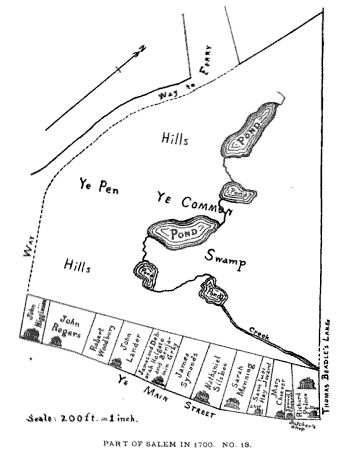
The land Higginson owned was later purchased by the East Church who built a Gothic Revival-style church there, between 1844-1846, which still stands today.
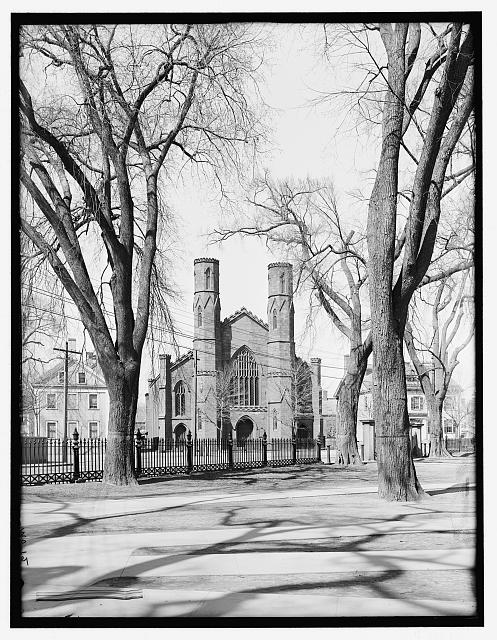
In 1972, the new owners of the property, Holly and Tom Mulvihill, opened the Salem Witch Museum in the old church building to appeal to the new tourists flocking to Salem after the publication of The Crucible and the airing of the “Salem Saga” episodes of Bewitched.
♦ Site of Ann Pudeator’s House: Address: 35 N Washington Square, Salem, Mass
Ann Pudeator was a widow and midwife who was accused of witchcraft in May of 1692 and hanged on September 22, 1692.
At the time of the witch trials, Pudeator lived in a home at this address. It is not known what happened to the home but a Federal-era brick mansion now stands on this spot.
♦ William Murray’s House: Address: 39 Essex Street, Salem, Mass. No admission. Privately owned home
William Murray served as a court clerk in the Salem Witch Trials and also provided testimony against accused witch Alice Parker .
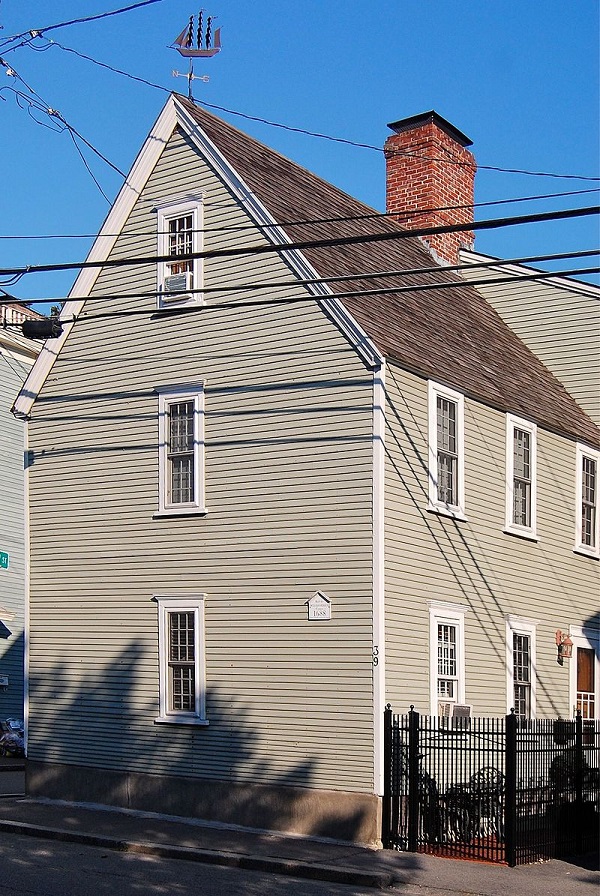
At the time of the witch trials, Murray was living in this house, which was built in 1688. The building has been heavily renovated since it was first built. The building is now privately owned.
♦ Former Site of Alice Parker’s House: Address: English Street, Salem, Mass. Exact location is believed to have been in what is now the parking lot behind the fence of the Salem Harbor Power Station.
Alice Parker was accused of witchcraft in May of 1692. At the time of the witch trials, she was living in a house, located somewhere on this spot, which she rented from fellow witch trial victim Phillip English.
Parker was found guilty and hanged at Proctor’s Ledge on September 22, 1692. It is not known what happened to her house after the witch trials but it no longer exists.
♦ Site of Reverend Nicholas Noyes Home Address: 90 Washington Street, Salem, Mass.(Southern corner of Washington and Lynde Streets)
Site previously occupied by a large wooden house owned by Rev. Nicholas Noyes who officiated as the clergymen at many of the Salem Witch Trials executions . It is not known what happened to the house but in 1764, Judge Benjamin Pickman built a large brick house there. The spot is currently occupied by a commercial building.
♦ Site of First Church of Salem Meetinghouse Address: 231 Essex Street, Salem, Mass
Many of the examinations that took place in Salem town were held at this meetinghouse, including Elizabeth Proctor’s examination on April 11, 1692. Also, on June 2, 1692, when Bridget Bishop was escorted from the Salem jail to the courthouse she glanced at the meetinghouse at the same moment that something crashed inside. When a board was later found out of place many believed it was confirmation that Bishop was a witch. Also, on July 3, 1692, Rebecca Nurse was excommunicated by Reverend Nicholas Noyes at this meetinghouse as was Giles Corey in September. A memorial plaque is located on the northeast corner of the brick building that occupies this spot today.
♦ Site of the Salem Witch Trials Executions: Address: Proctor’s Ledge, small hill between Proctor and Pope Street, Salem, Mass
A total of 19 convicted witches were hanged at Proctor’s Ledge, a small hill near Gallows Hill, between June and September of 1692. The Proctor’s Ledge Memorial was built at the foot of the hill in 2017.
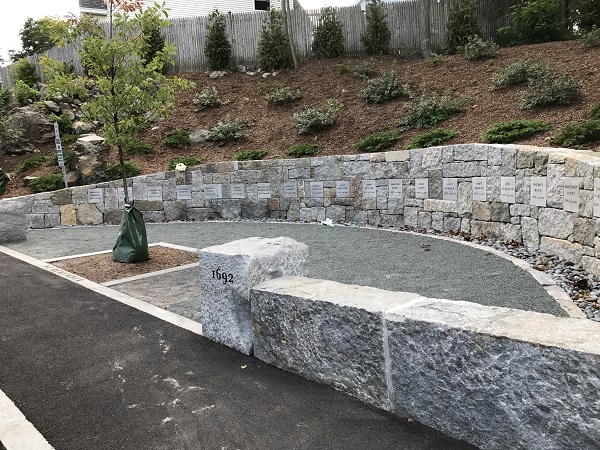
♦ Site of Philip English’s Mansion: Address: 11 Essex Street, Salem, Mass
Phillip English was a wealthy merchant who was accused of witchcraft in April of 1692. At the time of the trials, English lived in a large mansion on Essex Street which he built in 1686.
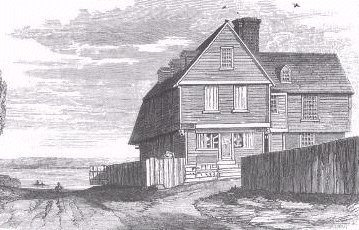
After English was arrested in May, he managed to escape the Boston jail with his wife and fled to New York. He later returned to Salem after the witch trials ended. English’s mansion stood for almost 150 years until it was razed around 1833.
♦ Phillip English’s Grave: Address: St Peter’s Episcopal Church, 24 St. Peter Street, Salem, Mass
In 1733, Phillip English donated a section of land, on the corner of Brown and St. Peter Street, to build a small wooden church called the St. Peter’s Episcopal Church . A small cemetery was also established around the church in which Phillip English was buried when he died in 1736.
In 1833, the wooden church was taken down and the stone church that exists there now was built in its place. The new church was much larger than the old one and, as a result, it was built on top of some of the graves in the cemetery, including English’s grave. English’s body is buried underneath the church’s chapel and a small exhibit in his honor can be found inside the church.
♦ Salem Witch Trials Memorial: Address: Liberty Street, Salem, Mass
The Salem Witch Trials Memorial was built in 1992 to honor the victims of the Salem Witch Trials and mark the 300th anniversary of the Salem Witch Trials.
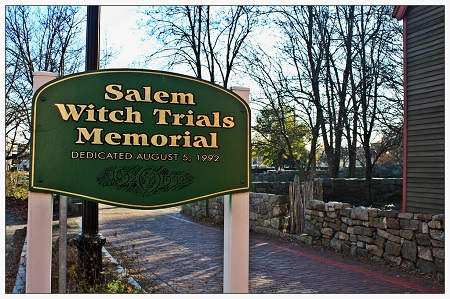
The memorial was dedicated by Nobel laureate-winner and Holocaust survivor Elie Wiesel in August of 1992 as part of the Salem Witch Trials Tercentenary. The memorial is adjacent to the Old Burying Point Cemetery where Judge John Hathorne is buried.
SALISBURY, MASS:
♦ Major Robert Pike’s Grave: Address: Salisbury Colonial Burying Ground, Beach Road, Salisbury, Mass
Major Robert Pike was one of the most prominent citizens of Salisbury, Mass and served as an assistant for the colony and a Justice of the Peace. Pike recorded most of the testimony given against Susannah Martin.
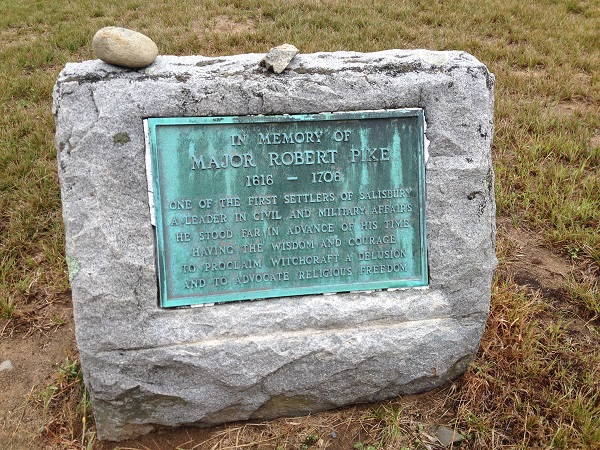
In August of 1692, Pike wrote a letter to Judge Jonathan Corwin attacking the validity of spectral evidence and criticized the logic of the trials by asking why the accused would deny they are witches but then practice witchcraft “in the sight of all men, when they know their lives lie at stake by doing it? Self-interest teaches everyone better.”
Pike also signed an affidavit in defense of another Salisbury woman accused of witchcraft, Mary Bradbury, who was his son’s mother-in-law. Pike was buried here after he died in 1706 at the age of 90.
♦ Mary Perkins Bradbury’s Grave Address: Salisbury Colonial Burying Ground, Beach Road, Salisbury, Mass
Mary Perkins Bradbury was the wife of Captain Thomas Bradbury of Salisbury and was accused of witchcraft by the afflicted girls of Salem Village in July of 1692.
Bradbury was tried and convicted of witchcraft in September but her execution was delayed and she was eventually released. She was buried here after she died of old age sometime around or just prior to the year 1700.
PEABODY, MASS:
♦ Site of John Proctor’s Farm: Address: Lowell Street, one-tenth mile south of Prospect Street, Peabody, Mass. No admission. Privately owned land.
John Proctor was the first male accused of witchcraft during the Salem Witch Trials. He was accused in April of 1692 during his wife Elizabeth Proctor’s examination.
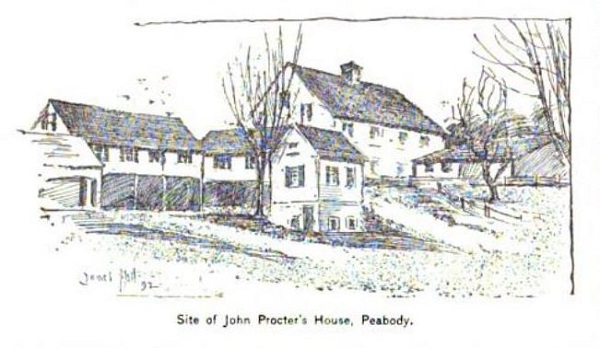
At the time, the Proctor family was living on this farm, where Proctor also ran a tavern called the Proctor Tavern, in what was then the outskirts of Salem Village.
After Proctor’s arrest, Sheriff George Corwin raided the farm and confiscated all of the beer, food and valuables on the property.
John Proctor was found guilty on August 5 and executed on August 19, 1692 at Proctor’s Ledge in Salem. Proctor’s family reportedly retrieved his body from the execution site and buried it on the northeast corner of the family farm.
The farm was later passed down to Proctor’s son, Benjamin, and it remained in the family until the late 1800s. It is not known what happened to Proctor’s original house but there is another house still standing on the property that is often referred to as the John Proctor house despite the fact that historians believe it was built in the 1700s by Proctor’s son Thorndike Proctor. The house and the farm are privately owned.
♦ Nathaniel Felton, Sr, House: Website: www.peabodyhistorical.org Address: 47 Felton Street, Peabody, Mass Hours: Open by appointment only
Nathaniel Felton, Sr, was a neighbor of John Proctor. He came to the defense of John and Elizabeth Proctor and Rebecca Nurse in 1692 when he signed a petition calling for their release from jail. At the time of the witch trials, Felton was living in this house in Peabody.

The house was built in 1644, making it the oldest house in Peabody. The house remained in the Felton family for over two centuries until 1902 when it was sold a wealthy shoe manufacturer named Joseph Smith. In 1983, the widow of Joseph Smith’s grandson gave the house to the Peabody Historical Society who later opened it up as a historic house museum.
♦ Nathaniel Felton, Jr, House: Website: www.peabodyhistorical.org Address: 43 Felton Street, Peabody, Mass Hours: Open by appointment only
Nathaniel Felton, Jr, also came to the defense of accused witches John and Elizabeth Proctor and Rebecca Nurse. At the time of the witch trials, Felton, Jr., was living in this house in Peabody.
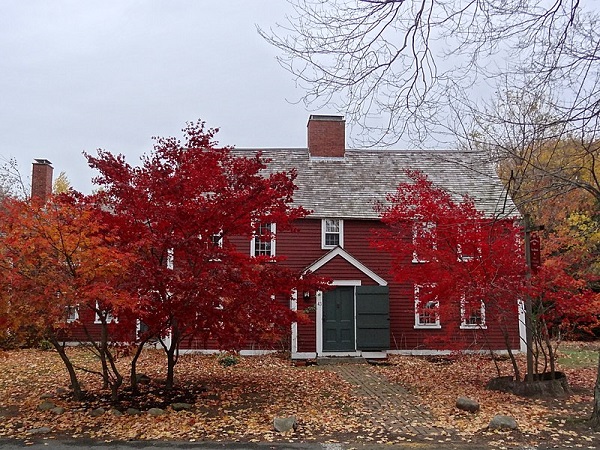
The house was built in 1683 and remained in the Felton family for almost two centuries until 1902 when it was sold a wealthy shoe manufacturer named Joseph Smith. In 1976, the widow of Joseph Smith’s grandson gave the house to the Peabody Historical Society.
♦ Giles and Martha Corey Memorial Markers: Address: off of Lowell Street, near Crystal Lake in Peabody, Mass
Two memorial markers dedicated to Giles and Martha Corey are located here near the former site of the Corey farm.

MARBLEHEAD, MASS:
♦ Site of Wilmot Redd’s House: Address: corner of Pond and Norman Streets, Old Burial Hill near Redd’s Pond, Marblehead, Mass
Wilmot Redd was the wife of a Marblehead fisherman. She was accused of witchcraft in May of 1692 and brought to Ingersoll Tavern in Salem Village to be examined by a judge.
At the time of her arrest, she was living in a house next to Old Burial Hill in Marblehead , on the southeast corner of what is now Redd’s pond. Redd was found guilty in September and was among the last victims of the witch trials when she was hanged on September 22, 1692.
It is not known what happened to Redd’s house after the witch trials but the house no longer exists. The pond near the site of her home was later named after Redd. There is also a memorial marker for Wilmot Redd located on Old Burial Hill.
♦ Ambrose Gale House: Website: www.marbleheadhistory.org Address: 17 Franklin Street, Marblehead, Mass
Ambrose Gale was a Marblehead fisherman and merchant who testified against Wilmot Redd during the Salem Witch Trials. According to the Marblehead Historical Commission’s website, Gale was living in this house in Marblehead at the time of the trials.
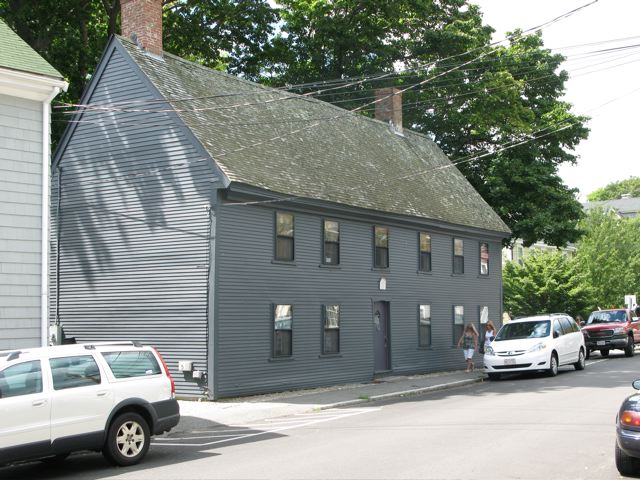
Built in 1663, it is the oldest house in Marblehead and it is currently owned by the Marblehead Historical Commission.
IPSWICH, MASS:
♦ Former Site of the James & Elizabeth Howe Farm: Address: 417 Linebrook Road, Ipswich, Mass
Elizabeth Howe was a woman from Topsfield who was accused of witchcraft in May of 1692. At the time she was living on this farm with her children and blind husband.
After Howe was arrested she was brought to Ingersoll Tavern in Salem Village to be examined by Judge John Hathorne and Judge Jonathan Corwin. She was indicted on two charges of witchcraft and led to jail, probably either the Salem jail or a jail in Ipswich. Howe was found guilty and hanged at Proctor’s Ledge on July 19, 1692.
The farm remained in the family for several generations. In 1911, the former location of the Howe homestead on the farm was discovered by a writer investigating the history of the Salem Witch Trials.
The site of the homestead at the time was only a hole in the ground where the cellar used to be. The Howe descendants living on the property at the time referred to it as Mary’s hole, after Elizabeth Howe’s daughter, Mary, who lived in the house after her mother’s execution. The site was later excavated in 2006.
HAVERHILL, MASS:
♦ Major Nathaniel Saltonstall’s Grave: Address: corner of Water and Mill Streets, Pentucket Cemetery, Haverhill, Mass
Major Nathaniel Saltonstall was a judge in the Salem Witch Trials. Saltonstall resigned from the court in June of 1692 and was replaced by Judge Jonathan Corwin.
After his resignation, Saltonstall became a prominent critic of the trials. He was then accused of witchcraft himself but never stood trial. Saltonstall was buried here after he died in 1707 of a consumptive illness.
DORCHESTER, MASS:
♦ Chief Justice William Stoughton’s Grave: Address: corner of Stoughton Street and Columbia Road in Dorchester, Old Burying Ground, Dorchester, Mass
William Stoughton was the Chief Justice in the Salem Witch Trials. Stoughton was buried here after he died in 1701 at the age of 70.
DANVERS, MASS:
♦ Rebecca Nurse Homestead : Website: www.rebeccanurse.org Address: 149 Pine Street, Danvers, Mass
Rebecca Nurse was an elderly grandmother from Salem Village who was accused of witchcraft in March of 1692. At the time of the witch trials, she lived in this large house which then sat on 300 acres of land.

The house is the only home of a person executed during the trials that is open to the public. The house and farm were originally established in 1636 by Townshend Bishop when he was granted 300 acres of land in Salem Village.
In 1641, Bishop sold the estate to Henry Chickering who then sold it to Governor Endicott in 1648 for one hundred and sixty pounds. Endicott gave the farm to his son, John, in 1653.
John died in 1668 and he left it to his wife, who then married Reverend Samuel Allen of the First Church of Salem. When she died in 1673, the farm became the property of Allen who sold it to Francis Nurse, Rebecca’s husband, in 1678.
After Rebecca Nurse was accused of witchcraft in 1692, she was arrested at the house on March 23 and was lodged at Ingersoll’s tavern for the night before being examined at the tavern the next day.
Rebecca Nurse never returned to her house again and was hanged on July 19, 1692 at Proctor’s Ledge in Salem town. The farm stayed in the Nurse family until it was inherited by the Putnam family in 1784.
In 1908, the Rebecca Nurse Memorial Association purchased the house and 27 acres to preserve it. In 1909, the house underwent a renovation by the architect Joseph Chandler. The house was opened to the public in 1909 as Danvers’ first historic house museum.
Also located on the property is the Nurse family cemetery which reportedly is the location of Rebecca Nurse’s unmarked grave. Family legend states that Nurse’s son secretly retrieved her body from the execution site and buried her in the family cemetery.
In 1992, a body believed to be that of fellow witch trials victim, George Jacobs, was moved to the Nurse family cemetery after it was discovered on the nearby Jacobs property.
In 1885, the Nurse family association erected a granite obelisk monument in the cemetery in Nurse’s honor. In 1926, the association gave the property to the Society for the Preservation of New England Antiquities.
In 1981, the Danvers Alarm List Company, a colonial history organization, bought the property to preserve and restore it to its colonial-era appearance. Since then, the company has been slowly restoring the building, removing modern fixtures, re-establishing the original land contour, building period fencing, and re-establishing the kitchen garden and orchard.
♦ Salem Village Parsonage Archaeological Site: Address: Rear 67 Centre Street, Danvers, Mass (site is accessible via a cart path.)
This was the site of the Salem Village Parsonage where Reverend Samuel Parris , his daughter Betty Parris , his niece Abigail Williams and his slaves Tituba and John Indian lived during the Salem Witch Trials. After the trials ended, the Parris family moved away and a new minister was appointed.
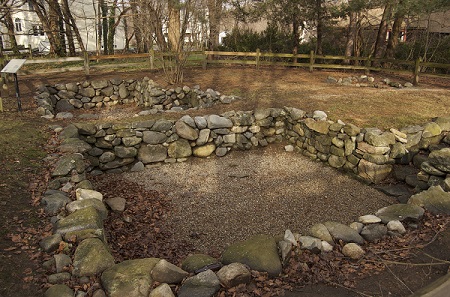
It is not known what happened to the original parsonage, but by the 19th century the building was gone and the land was being used for agricultural purposes. During the 19th century and most of the 20th century, the exact location of the old parsonage was marked only by a small granite marker.
In 1970, local historian and archivist Richard B. Trask excavated the site of the old parsonage and the site is now open to visitors.
♦ Sarah Osbourn House: Address: 273 Maple Street, Danvers, Mass. No admission. Privately owned home.
Sarah Osbourn was one of the first women accused in the Salem Witch Trials when she was accused in February of 1692. She was examined before a judge, along with Tituba and Sarah Good , at the Salem Village Meetinghouse on March 1, 1692. Osbourn never stood trial because she died in jail shortly after.
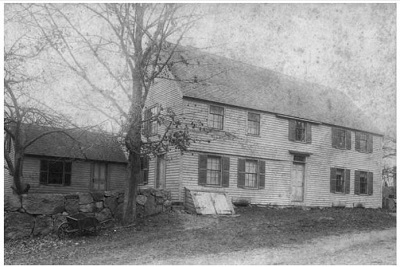
At the time of her arrest, Osbourn was living in this house, which was then located on Spring Street. The house was built sometime between 1660-1680. In 1914, it was moved from Spring Street to Maple Street. Not much is known about the history of the house before or after the Salem Witch Trials except that it is now a privately owned home.
♦ Sarah Holten House: Website: www.dar.org Address: 171 Holten Street, Danvers, Mass Hours: Open by appointment only
Sarah Holten was a a woman who gave damaging testimony against Rebecca Nurse during the Salem Witch Trials. During the time of the trials, Holten lived in this house on what is now Holten Street.
The house was originally built in 1670. It was later also the home of Judge Samuel Holten, a physician, statesman and judge, who was a signer of the Articles of Confederation and served in the Continental Congress in the 1770s and 1780s. The house in now owned by the General Israel Putnam Chapter of the Daughters of the American Revolution.
♦ Former Site of George Jacobs’ House: Address: Margin Street, Danvers, Mass
George Jacobs, Sr, was an elderly grandfather living in Salem Village when he was accused of witchcraft in May of 1692. He was arrested at his house alongside his granddaughter, Margaret, who was also accused and was examined by Judge John Hathorne and Judge Jonathan Corwin. Jacobs was indicted on two charges of witchcraft and brought to jail.
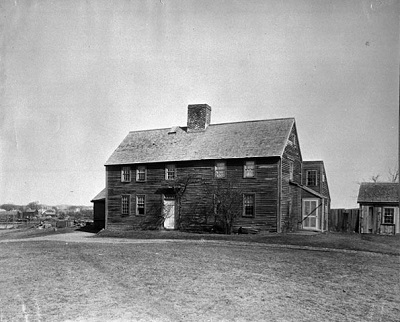
At the time of the witch trials, Jacobs was living in a center-chimney farmhouse on Margin Street that he built in the late 1600s. Jacobs was later found guilty and executed on August 19, 1692. According to family legend, his body was secretly retrieved from the execution site and buried on the family property.
The house survived until the early 20th century but became neglected and rundown by 1938 and was demolished sometime around 1940. In 1992, an unidentified body believed to be Jacobs was found on the property and moved to the Nurse homestead so the property could be sold.
♦ Ingersoll Tavern: Address: 199 Hobart Street, Danvers, Mass. No admission. Privately owned home.
This was the former home of Deacon Nathaniel Ingersoll. Ingersoll also ran a tavern from this house during the time of the Salem Witch Trials. Some of the accused witches were examined before a judge at Ingersoll’s Tavern before they were brought to trial.
The house remained a tavern until either the late 1700s or early 1800s but eventually became rundown and was purchased by the First Church of Salem in 1832 and renovated to become a parsonage. The house is still standing but is a privately owned home.
♦ Salem Village Witchcraft Victims’ Memorial: Address: 176 Hobart Street, Danvers, Mass
This memorial was built in 1992 to honor the victims of the Salem Witch Trials and mark the 300th anniversary of the trials. It was built on Hobart street, opposite of the former site of the Salem Village Meetinghouse.

The memorial was dedicated in May of 1992, during the Danvers Witchcraft Tercentennial Commemoration.
♦ Former Site of the Salem Village Meetinghouse: Address: Near corner of Hobart and Forest Street, Danvers, Mass. Historical marker on site.
This is the site of the Salem Village Meetinghouse where some of the accused witches were examined before a judge before they were brought to jail.

The meetinghouse was abandoned and then moved across the street and re-purposed into a barn but slowly fell into ruins. By the mid 1800s the building was gone. A historical marker is located on site. A replica of the Salem Village Meetinghouse can be found at the Rebecca Nurse Homestead in Danvers.
♦ Former Site of the Salem Village Church: Address: Corner of Hobart Street and Centre Street, Danvers, Mass
This is the site of the Salem Village Church where some of the accused witches and their accusers attended church during the Salem Witch Trials.
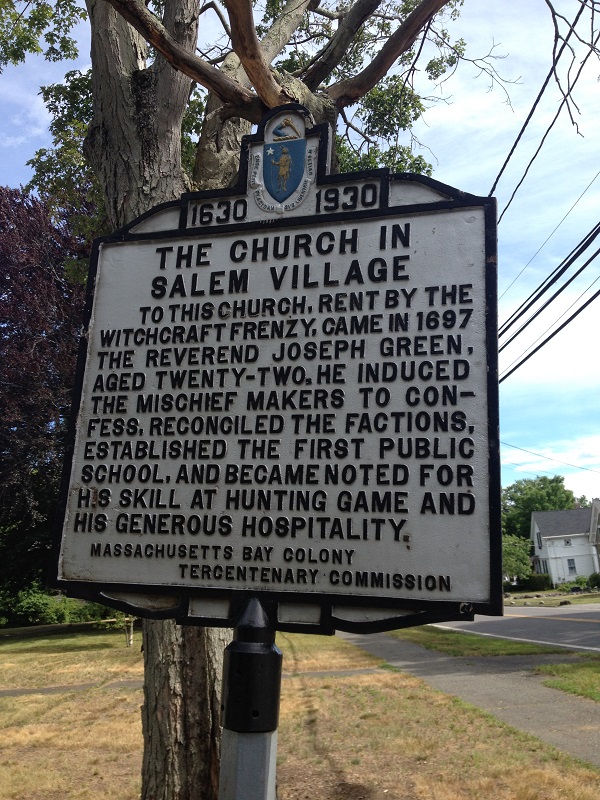
Some of the afflicted girls exhibited symptoms of their affliction during services here in the spring of 1692 and some of the accused where excommunicated here. A historical marker is located on the site. The First Church of Danvers Congregational now occupies the spot.
♦ Ann Putnam, Jr, Ann Putnam, Sr, & Thomas Putnam’s Graves: Address: Putnam burial ground, 485 Maple Street, Danvers, Mass
The Putnam family were the main accusers during the Salem Witch Trials. Thomas Putnam was buried here after he died in May of 1699 at the age of 47. His wife Ann Putnam, Sr., was buried here a few weeks later in June of 1699. Their daughter, Ann Putnam, Jr , was buried here after she died in 1716 at the age of 37. Their graves are unmarked.
BEVERLY, MASS:
♦ Reverend John Hale Farm: Website: www.beverlyhistory.org Address: 9 Hale Street, Beverly, Mass Hours: June-October: Saturdays 11am to 3pm. July-August: Fridays & Saturdays: 11am-3pm.
Reverend John Hale was a minister from Beverly who assisted court officials during the Salem Witch Trials. Hale later became a critic of the witch trials after his wife was accused of witchcraft.
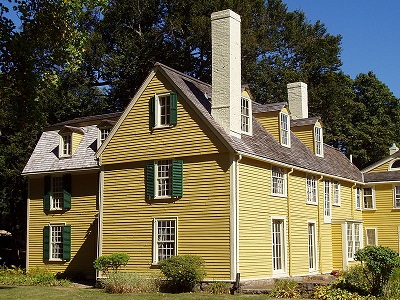
At the time of the trials, he was living in this farmhouse in Beverly, which had been deeded to him along with 200 acres of land by his parish. After the witch trials ended, Hale wrote a book about the trials, titled A Modest Inquiry Into the Nature of Witchcraft, which was published posthumously in 1702. Hale died in this home on May 15, 1700.
The farm remained in the family for several generations and many renovations and alterations were made to the house over the years. In 1937, it was sold to the Beverly Historical Society and was opened to the public as a historic house museum.
♦ Reverend John Hale’s grave: Address: Abbott Street Burial Ground, Beverly, Mass
Reverend John Hale was buried here after he died in 1700 at the age of 64.
BOSTON, MASS:
♦ Judge Samuel Sewall’s Grave: Address: Tremont Street, Granary Burying Ground, Boston, Mass
Samuel Sewall was a judge in the Salem Witch Trials. Sewall later issued a public apology for his role in the trials on January 15, 1697, during an official day of prayer and fasting in honor of the witch trial victims. Sewall was buried here after he died on January 1, 1730 at the age of 78.
♦ Cotton Mather’s Grave: Address: Copp’s Hill Burying Ground, 45 Hull Street, Boston, Mass
Cotton Mather was a Boston minister who assisted the court during the Salem Witch Trials. Mather later wrote a book about the trials, titled Wonders of the Invisible World. Mather was buried here when he died in 1728 at the age of 65.
AMESBURY, MASS:
♦ Site of Susannah Martin’s house: Address: end of North Martin Road, Amesbury, Mass
Susannah Martin was a poor widow living in Amesbury when she was accused of witchcraft in May of 1692. She was arrested and brought to Salem Village where she was examined by Judge John Hathorne and Judge Jonathan Corwin. She was indicted on two charges of witchcraft and led to jail.
At the time of the witch trials, Martin was living in a home on what is now North Martin Road. Martin was found guilty and executed on July 19, 1692. It is not known what happened to the house after the witch trials but Amesbury residents later placed a large boulder with a memorial plaque near the former site of her home.
Andover, Mass:
♦ Benjamin Abbott House Address: 9 Andover Street, Andover, Mass. Admission: Private home. No Admission.
Home of Benjamin Abbott who accused Martha Carrier of bewitching him.
♦ Old North Parish Burial Ground Address: Academy Road, North Andover, Mass. Admission: Free admission.
Burial place of the afflicted person Timothy Swan as well as Andover minister during the Salem Witch Trials, Rev. Thomas Barnard, and accused witches William Barker Sr and William Barker Jr.
If you’d like to learn about more historic sites in the state, check out this article on Massachusetts historic sites .
Sources: “Reverend Nicholes Noyes Home, Site Of.” Salem Witch Museum, salemwitchmuseum.com/locations/reverend-nicholas-noyes-home-site-of/ “Judge Samuel Holten House.” Essex National Heritage Area , www.essexheritage.org/attractions/judge-samuel-holten-house “Witchcraft Victim’s Memorial.” Danvers Archival Center , Peabody Institute Library and Richard Trask, www.danverslibrary.org/archive/?page_id=750 “Witch Trials Self-Guided Tour.” Salem Witch Museum , www.salemwitchmuseum.com/SitesTour “Historical Sites of Danvers.” Salem Witch Trials Documentary Archive and Transcription Project , University of Virginia, n.d., salem.lib.virginia.edu/Danvers.html “Redd’s Pond.” Old Burial Hill , www.oldburialhill.org/redds/redds_pond_01a.html Swift, Adam. “A Walking Tour of Salem Witch Sites with the Salem Historical Society.” Salem Patch , 29 Oct. 2015, patch.com/massachusetts/salem/walking-tour-witch-sites-salem-salem-historical-society-0 Larkin, Jack. Where We Lived: Discovering the Places We Once Called Home . The Taunton Press, 2006. Historical Collections of the Danvers Historical Society, Volumes 6-9 . Danvers Historical Society, 1918. Drake, Samuel Adams. Our Colonial Homes . Lee and Shepard, 1894. Robinson, John. Visitors’ Guide to Salem. Essex Institute, 1895. The Essex Antiquarian, Volume 3 . Edited by Sidney Perley. The Essex Antiquarian, 1899. Goss, K. David. Salem Witch Trials: A Reference Guide. Greenwood Press, 2008. Trask, Richard B. Danvers . Arcadia Publishing, 2002. Historical Collections of the Danvers Historical Society . Vols. 3-5. Danvers Historical Society, 1915. Perley, Sidney. The History of Salem, Massachusetts: 1671-1716 . S. Perley, 1928.
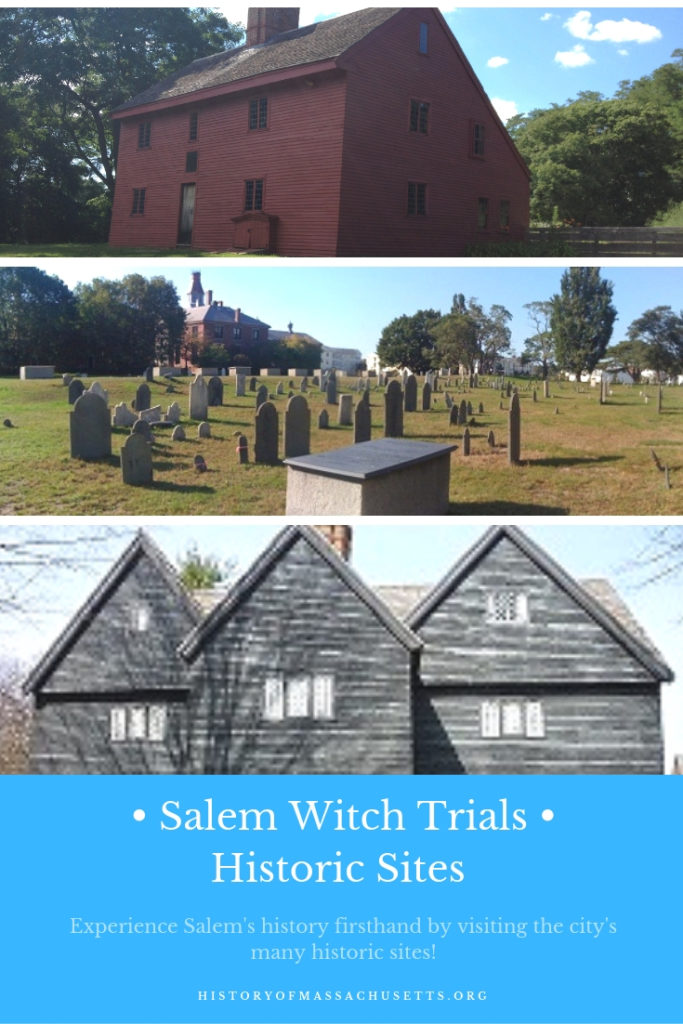
21 thoughts on “ Salem Witch Trials: Historical Sites & Locations ”
Thank you for posting this interesting material!
You’re welcome, John. I’m glad you liked it.
This was a great article. My step daughter went to Salem on a field trip just last week. I wish I had found this sooner! I’m going to go next week because I haven’t been there since I was a kid
Thanks Mike! Glad you liked the article. Hope you have fun in Salem next week!
Interesting and excellent information. Thank you!
I’m doing considerable family history work…
I discovered recently is that have a family connection to two individuals mentioned… 1) Capt. Thomas Fisk (jury foreman for the Rebecca Nurse trial) is my direct 8th Great Grandfather. 2) Giles Corey apparently killed Jacob Goodale around 1676. Jacob was the son of my 10th Great Grand Parents (Robert Goodale and Catherine -Kilham- Goodale). I am also directly related to Henry Herrick (juror on the Rebecca Nurse trial that eventually convicted her) and to Joshua Rea (signed a petition to save Rebecca Nurse).
Are you related to any Witch Trial connected individuals?
I plan to visit the Nurse and the Rea homesteads in the spring. Any additional advice? (e.g., grave sites, other homes).
Hi Guy, Thanks for your comment. As far as I know I’m not related to anyone involved in the witch trials (although some of my ancestors, the Fitchs, lived in the area at the time and had the same last name as some of the accusers in Esther Elwell’s case – so perhaps but I can’t find any evidence of it.) I included everything I know about the witch trial locations in this article so I don’t really have any additional advice except that one place I didn’t mention in the article is the General Israel Putnam house at 431 Maple Street in Danvers. Joseph Putnam lived there are the time but, unlike the other Putnams, he was a critic of the trials and refused to participate. His son Israel was born in the house and he later became a notable general in the American Revolution. The house is unfortunately closed due to a lack of funding but you can still view it from the street.
Anyway I can find more about judge Jonathan Corwin… We share the very same name and a few weird details! Thank you!
Great timing, Jonathan! I just wrote an article on Jonathan Corwin and plan on publishing it in about a week or so. Check the blog during the last week of January or subscribe to my email list to get all the latest articles delivered right to your inbox. You can also search for Corwin’s name in the search box at the top of the page for a handful of articles I wrote that mention Corwin, including an article I recently wrote about the Witch House in Salem.
Do you have anhything regard what haooened to the afflicted girls? Like their life after the trials and if yhey were punished for their crimes?
Hi Sammy, I’ve written several articles about specific afflicted girls including this one about Ann Putnam, Jr: https://historyofmassachusetts.org/ann-putnam-jr/ . That article contains links to the other articles about the girls.
Your research on Thomas Beadle’s Tavern conflicts with research I found at the Phillips Library some years ago.
There is a drawing, different from the one you have, and the book states the Tavern was “west of Daniels”, across from now Washington Square East; then Thomas Beadle’s Lane. From the drawing, it may be the house that is set back from Essex and borders the Salem Maritime site.
I have copies of the information if you are interested.
Hi Blaire, yes I am definitely interested. I’ll email you.
Hi, I’m doing a project on the Salem Witch trials. Thanks so much for making this for everyone to read. It was very useful and helpful. Have a great day!!
You’re welcome, Nola!
i am very annoyed simply because todays salem is taking credit to many vistors that this was where all of the witch hystera took place when actually most occured in salem village [ danvers now). If you don’t have a car you are out of luck to see these sites of interest as there is no touring bus that can take you there which i am sure there are many that would actually like to see the real sites. I think it a shame ! Most vistors think that present day Salem is where it all happened when it really didn’t ! They need to have a tour bus that would take those interested and i am sure there would be many without taking away other attractions that Salem has to offer.
The trials happened in both Salem and Danvers. It is true that many of the early accused and accusers lived in Danvers and many of the early examinations took place there but examinations also took place in Salem and the accused where held in the Salem jail (as well as Boston and Ipswich) and the actual trials were held in Salem at the Salem courthouse.
Where did Ann Putnam Jr live, and does her house still survive? I see 19th photos of her (purported) home online (on her Wikipedia entry, for example), but can’t find any reference to a location or final fate of the house. (It’s not the Israel Putnam house – that house has a different arrangement of windows vs. the old photos I’m finding of Ann Putnam’s house…)
Any ideas? Thank you!
I saw an old article about Elizabeth Phinney (finney) )bailey) tryed and aqquited if withcraft between 1647 and 1697, but on your site I can not find anything, Do you know of any information on her. She would be my 6th time great grandmother. Thank you M. Finney
Sorry but I don’t have any information on her.
I am a 10 th generation descendant from Martha Carrier from her son Andrew. They lived in Andover. Any information on location of their farm or any other info pertinent to her would be appreciated.
Hello, I enjoyed this article!! I am descended of the Feltons, Putnams and Bradburys. I have just started doing the deep research and this gives me even more to look into the next time I am down in the area.
Comments are closed.
First Church of Salem Meetinghouse, Site of
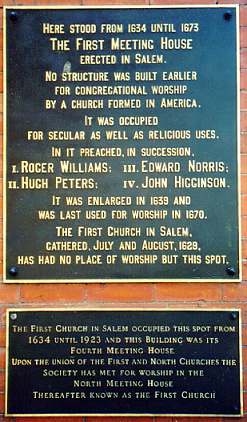
231 Essex St, Salem, MA, USA
The site of the meetinghouse was just adjacent to (closer to Washington Street) where the restaurant Rockafella’s is today, at 231 Essex Street. Near the northeast corner of the building there is a marker noting the spot’s significance.
More About First Church of Salem Meetinghouse, Site of
Also questioned on April 11 was Sarah Cloyce, whose sisters Rebecca Nurse and Mary Easty were also accused of witchcraft. Cloyce was held for trial. Of the three sisters, only Cloyce would escape execution. Nurse was hanged on July 19 and Easty was hanged on September 22.
On June 2, Bridget Bishop was escorted from the Salem jail to the courthouse; this marked the first formal witchcraft trial. On this same day preliminary testimony was being gathered in several cases, and the intimate searching for “witch marks” on the bodies of Rebecca Nurse, Sarah Good, Elizabeth Proctor, Susannah Martin, and Ann Parker was underway in the Salem jail. As Bishop passed the meetinghouse, it is said, she glanced at the building at the same moment something crashed inside. A board was later found, torn from its usual place and lying some distance away. Many whispered this was confirmation of Bishop’s witchcraft, failing to note the building’s disheveled state and significant need of repair. The jury found Bishop guilty by day’s end and she was hanged on June 10.
The meetinghouse of the First Church was also where Reverend Nicholas Noyes oversaw the excommunication of Rebecca Nurse. On July 3, Nurse was taken to the meetinghouse and publicly excommunicated in front of the elders of the church, “by unanimous vote.” During his torture, Giles Corey was also excommunicated here, as he was “either guilty of witchcraft or suicide.”
Photo by Rachel Christ, Salem Witch Museum.


IMAGES
COMMENTS
Posted by blogger in Salem Ghost Tours. What started out as a local jailing facility, the Salem Jail has served as a multitude of differing functions, from condominiums to restaurants. After going through many renovations and remakes throughout its 200-plus years of operation, the Salem Jail was finally closed as a jailhouse in 1990 after the ...
When the City of Salem purchased the abandoned jail in 2001, it was for only one dollar. They desperately hoped that a developer would come along and reinvigorate life into the former jail. But it was not until 2009 that the New Boston Ventures proposed historic luxury apartments for a whopping $10.7 million.
Salem Jail in 1692, Site of. In 1692, the Salem jail was located on Prison Lane, today known as St. Peter Street. The building, at the corner of Prison Lane and County Street (present-day Federal Street) measured "thirteen feet stud, and twenty feet square, accommodated with a yard" when built as the county jail in 1684.
This granite prison is now the site of 36 luxury apartments. Both are commonly referred to as the Old Salem Jail and hold the terrifying secrets of Salem's horrific past. Read on to learn more, brave soul. Salem Witch Jail. The Salem Witch Jail was the original jail for the county of Essex County, Massachusetts. Built in 1684 for the whopping ...
The old Salem jail, also known as the Essex County Jail, is a historic jail in Salem, Massachusetts located next to the Howard Street Cemetery.. The jail was built between 1811 - 1813 on St. Peter Street after the old wooden jail on Federal Street, known as the Salem Witch Jail because it housed the accused witches in 1692, became too small to serve its purpose.
Full description. Take a walk through Downtown Salem's most historic and haunted outdoor areas. Although every tour is slightly different, each tour visits several locations. See 2 cemeteries, the Witch Trials Memorial, the location where an accused witch was tortured to death, filming locations from the movie "Hocus Pocus," the Old Salem Jail ...
This map was created based off of evidence cited in A Guide to the Salem Witchcraft Hysteria of 1692 by David C. Brown. Click on any of the white dots on the map for more information about the sites. ... Witch Trials Online Sites Tour ... Salem Jail in 1692, Site of. Learn More . Salem Public Library. Learn More . Salem Witch Trials Memorial.
More About Recommended Route Around Salem. 1 - Begin your tour at 70 Washington Street at the Site of the Salem Court House in 1692. 2 - The approximate Site of Reverend Nicholas Noyes's Home is just south, at 90 Washington Street. 3 - Continue south on Washington Street and cross Essex Street. Near the corner, near 118 Washington ...
Delve into Salem's dark history on a guided walking tour. Learn how a Puritan town transformed into the Witch City. Hear tales of betrayal, murder, and mystery. Discover how the witch trials influenced a 19th century author. Take a selfie in front of the Bewitched and Hocus Pocus filming locations.
Claire - United Kingdom October 20, 2023 - Verified booking. Maria October 13, 2023 - Verified booking. Product ID: 238532. Experience the best of Salem's history on a 1.5 hour guided walking tour; including the 1692 witch trials, Revolutionary history, TV & movies filmed in Salem, Presidential visits & more.
Capture the historic spirit of Salem's yesteryear on this award winning, daily, 90-minute walking tour. Hear stories of intriguing people, discover the truth about Salem's infamous Witch Trial Hysteria, experience the authentic story of Salem's most notorious murder, and find out what locations were used in the movie Hocus Pocus. More than fifteen stops dot the tour route, including Salem's ...
Dedicated in August 1992, the Salem Witch Trials Memorial is located on Liberty Street, Salem. It was designed by Maggie Smith and James Cutler to commemorate the 300th anniversary of the trials. The memorial is maintained by the volunteer community organization Voices Against Injustice.
On the Salem Ghost tour of Spellbound Tours, we visit haunted locations such as the old Salem jail, the Joshua Ward House, cemeteries & more! Book tickets now! ... Book your tickets now to secure your spot on Salem's number one haunted experience! Book Now Contact Us (978) 740-1876
Tickets start at $25 per person. Tours operate daily at 8 p.m. The company also offers a daytime tour at 2 p.m. [ View & Book Tickets .] Witch City Walking Tours - History & Hauntings of Salem ...
iSeeSalem.com walking tours was founded 2008 with the intent of offering Salem's tourists a new way to learn about the city and its history. iSeeSalem.com offers downloadable podcast walking tours of some of Salem's most popular sites. The podcast walking tour format allows tour takers to participate at their own pace and on their own time.
Historic Salem Jail. In May 2010 the renovated Salem Jail opened once again for residents. This time it featured vastly different amenities than it did when opened in 1813. The original portion of the granite jail and the Federal period Jailer's House were constructed in 1811-1813. The jail was remodeled and substantially enlarged to the west ...
Additional Information. Explore more about the Salem Night Tour by diving into the additional information provided for a comprehensive understanding of this hauntingly intriguing experience in Salem, Massachusetts. The tour, with product ID 226474, takes place in Salem, Massachusetts, offering visitors the chance to explore the city's eerie past.. Engage with Salem attractions such as the ...
Path from Jail to Execution. In 1692, convicted witches would be picked up at the jail, loaded into a cart, and escorted to the execution site by High Sheriff George Corwin, who would sign their death warrants. The path led south on Prison Lane (today St. Peter Street), right on Main Street (today Essex Street) heading west to the edge of town.
Salem Gaol site, 2-4 Federal Street. Some of the witch-hunt victims were incarcerated in the wooden Salem jail built in 1684. Most likely, Giles Corey (c. 1617-1692) was pressed to death on the grounds of the jail. In 1763, the jail was replaced by a larger one at the same property.
The original "gaol" (jail) was located on Federal Street, two blocks from the Witch Dungeon Museum (not on the Red Line). Continue along Lynde Street and turn right onto Washington Street… Salem City Hall at 93 Washington Street was built in 1837-38 from funds dispersed to Salem from a US Treasury Surplus. The Mayor's office and City ...
Site of the Salem Witch Jail, 10 Federal Street, Salem Ma, photographed by Frank Cousins, 19th century. In 1813, the old witch jail was abandoned when a new jail was built down the street. In 1863, Abner Cheney Goodell purchased the structure of the old jail and remodeled it into a home.
More About Salem Courthouse in 1692, Site of. The Court of Oyer and Terminer ("to hear and determine") was created by Governor William Phips in May of 1692. The court consisted of Chief Justice William Stoughton, plus eight successful merchants, landowners, and politicians of the day. They were: Jonathan Corwin, Bartholomew Gedney, John ...
231 Essex St, Salem, MA, USA. The site of the meetinghouse was just adjacent to (closer to Washington Street) where the restaurant Rockafella's is today, at 231 Essex Street. Near the northeast corner of the building there is a marker noting the spot's significance. 231 Essex St, Salem, MA, USA.